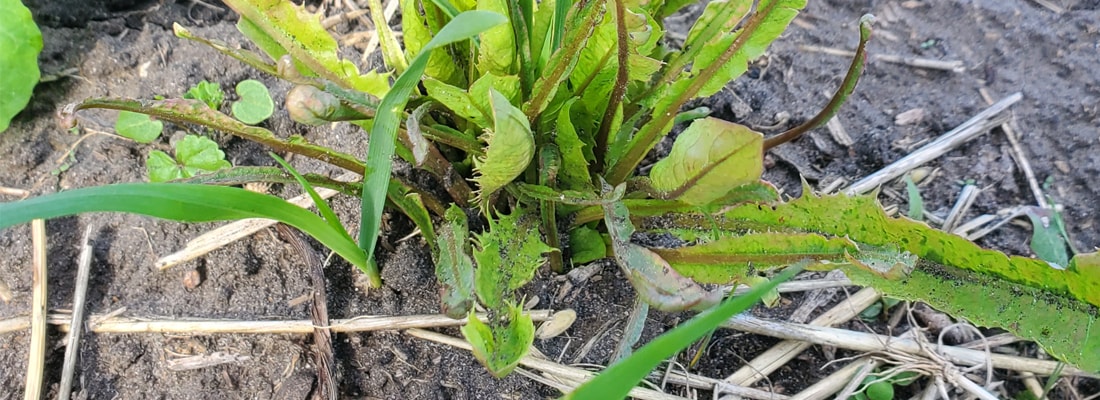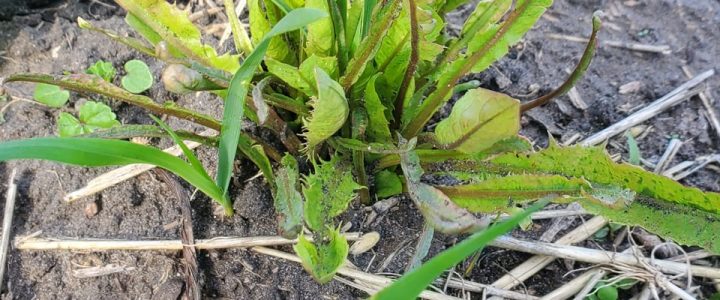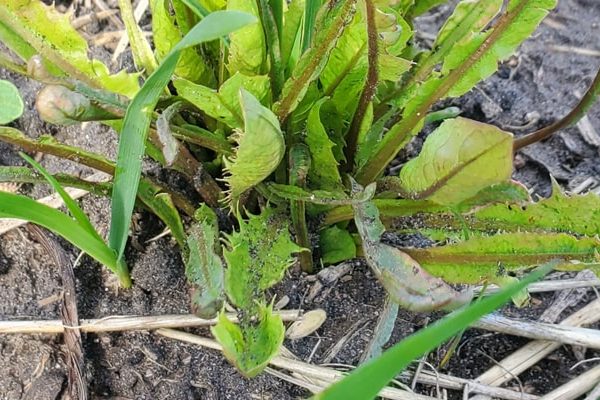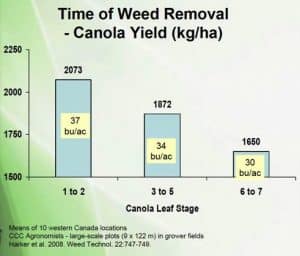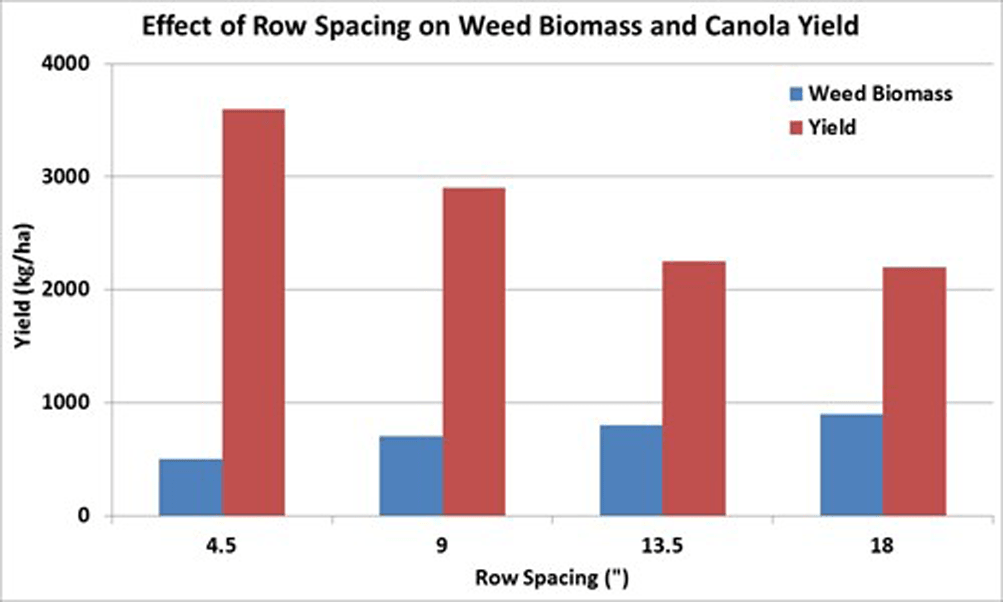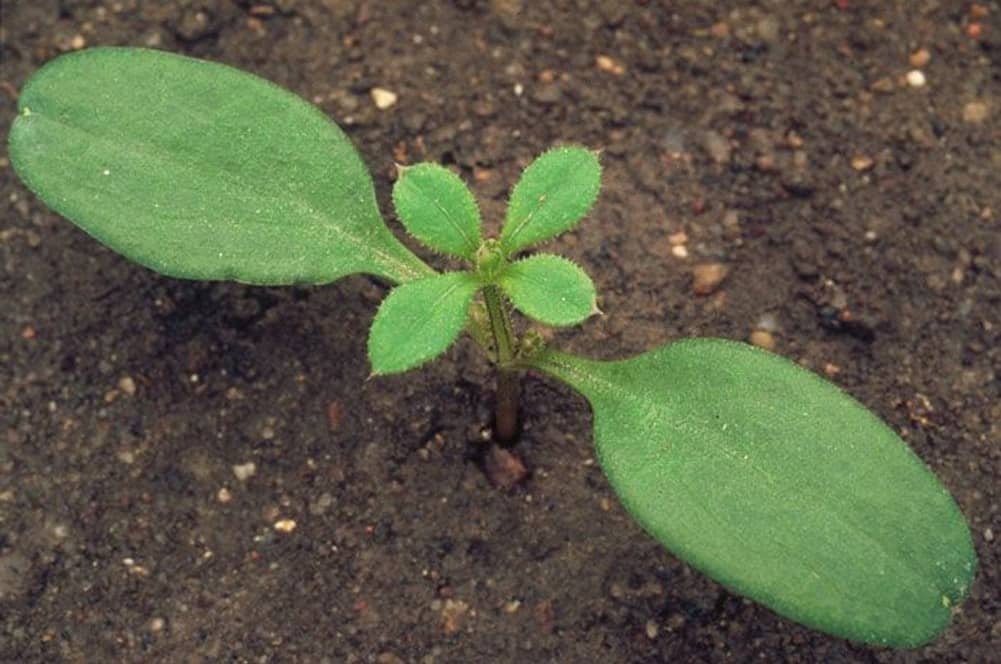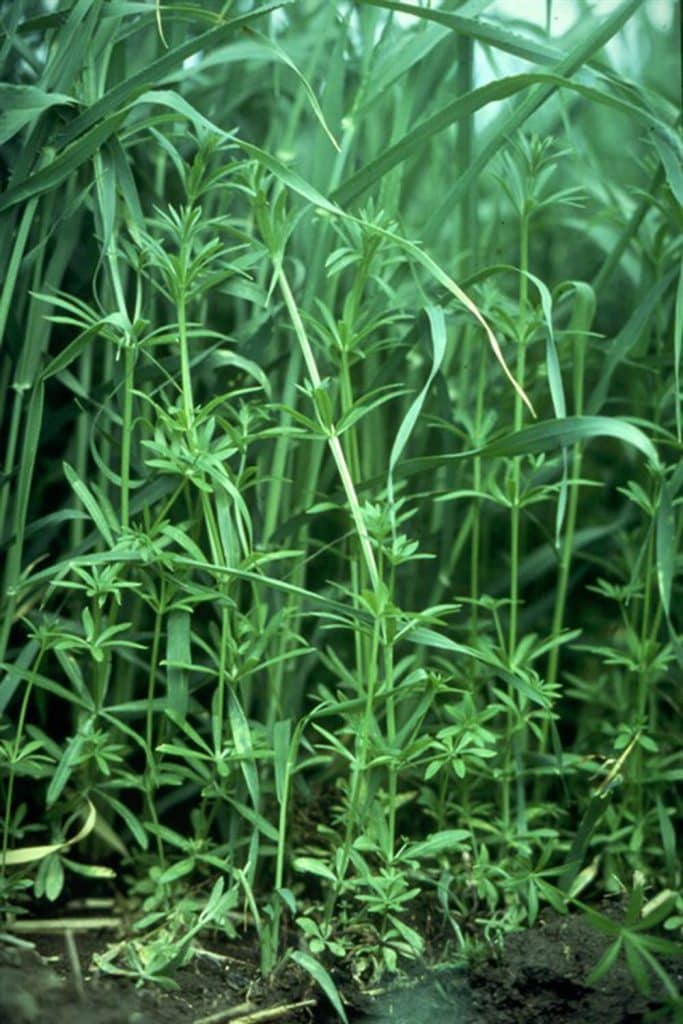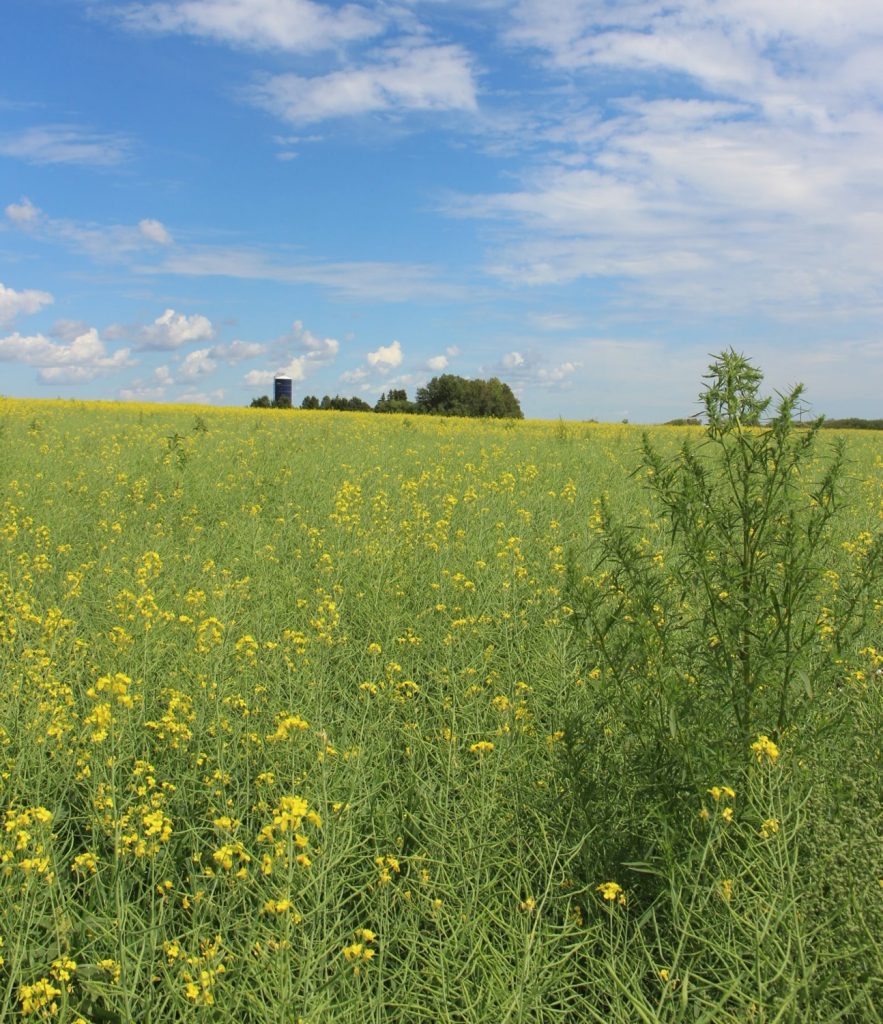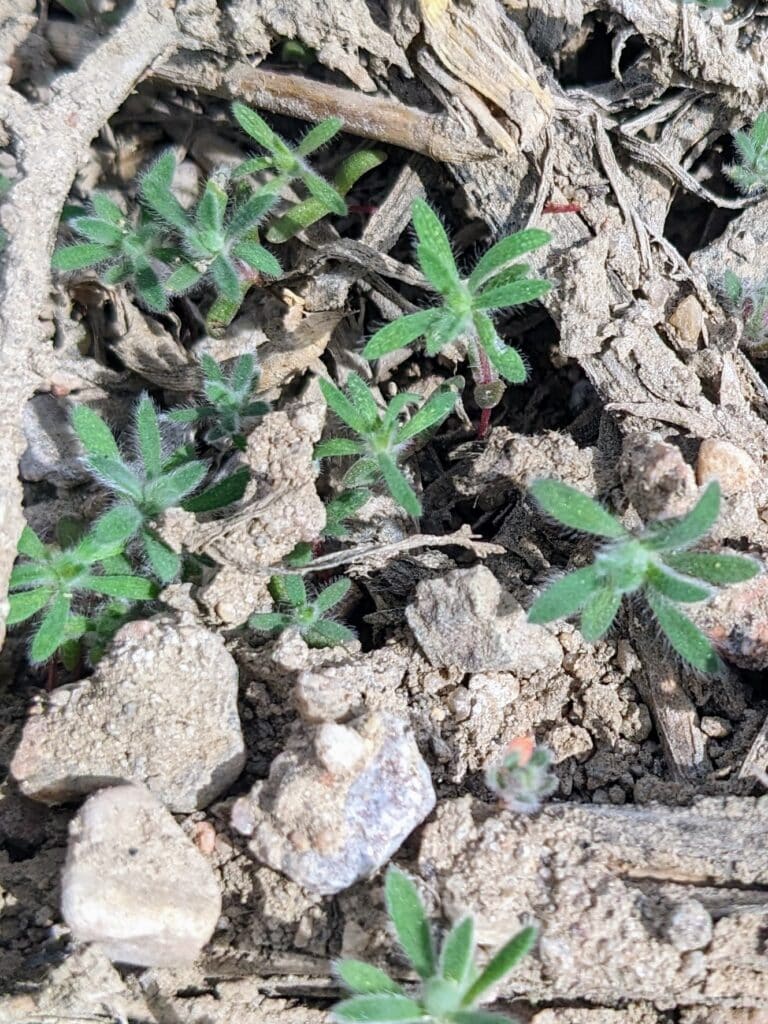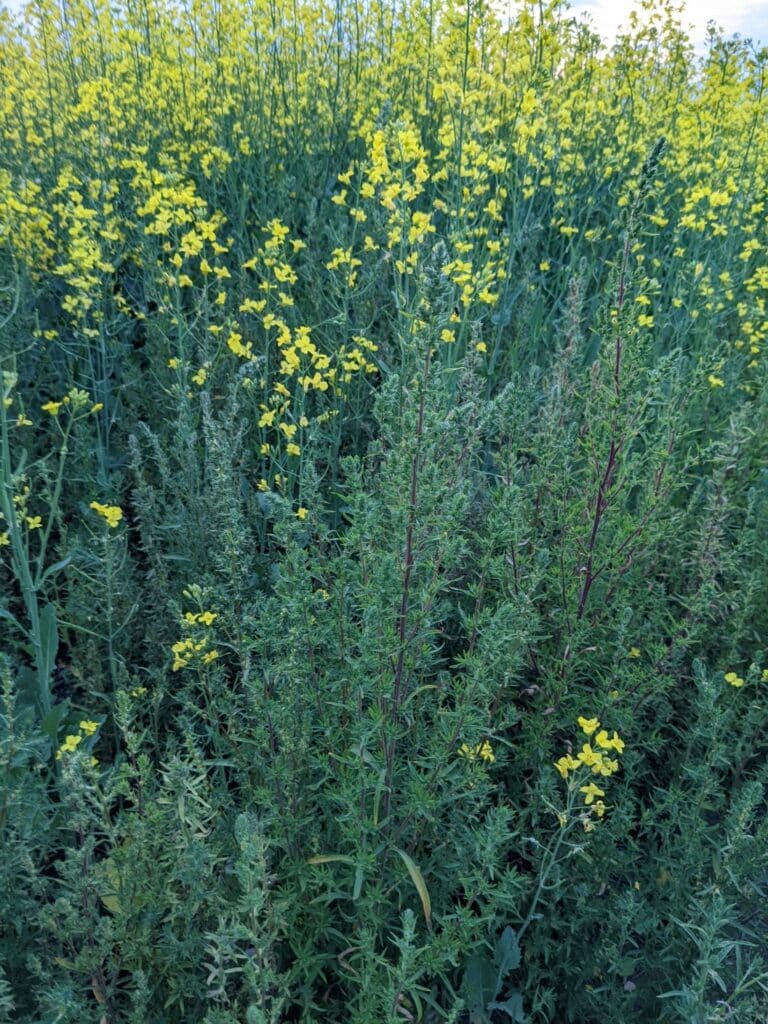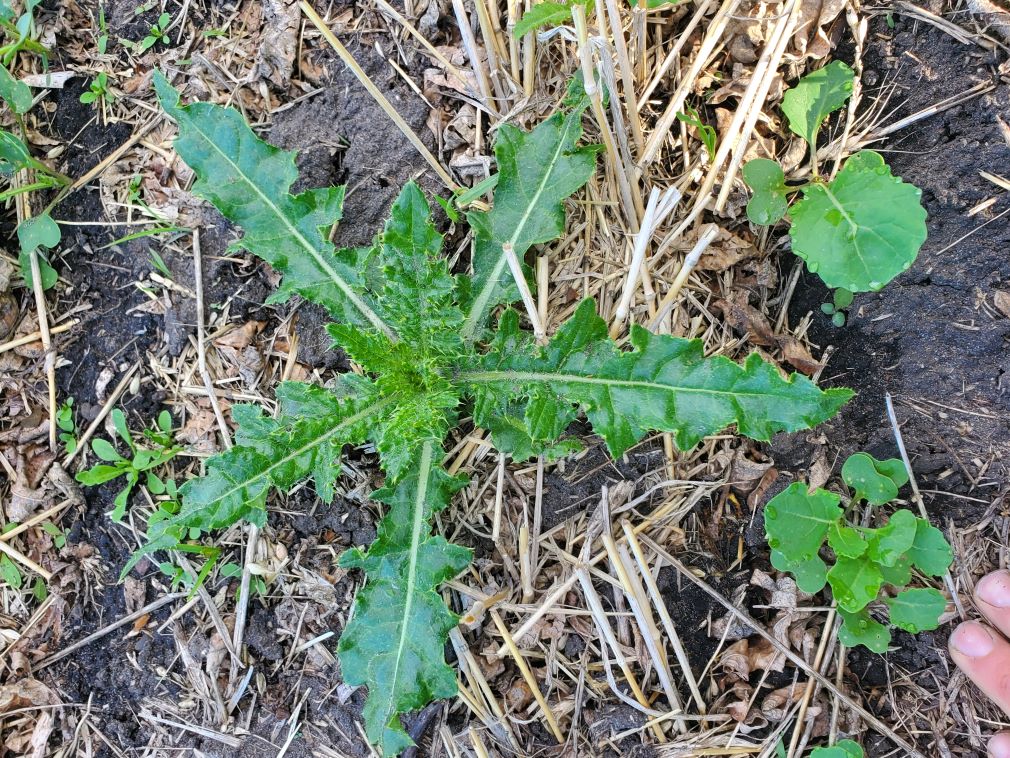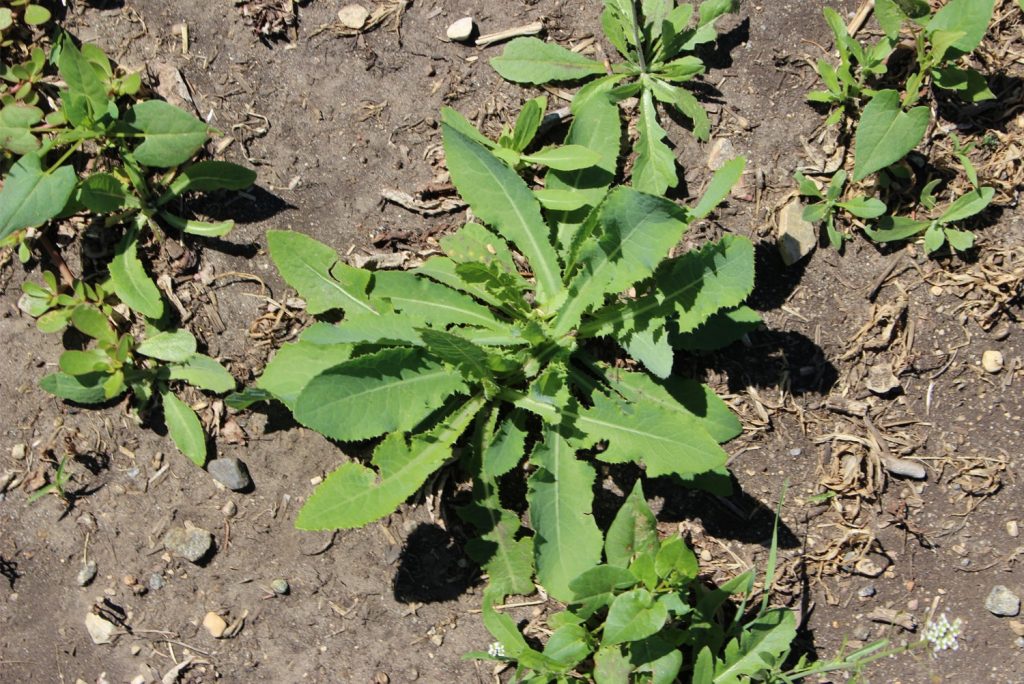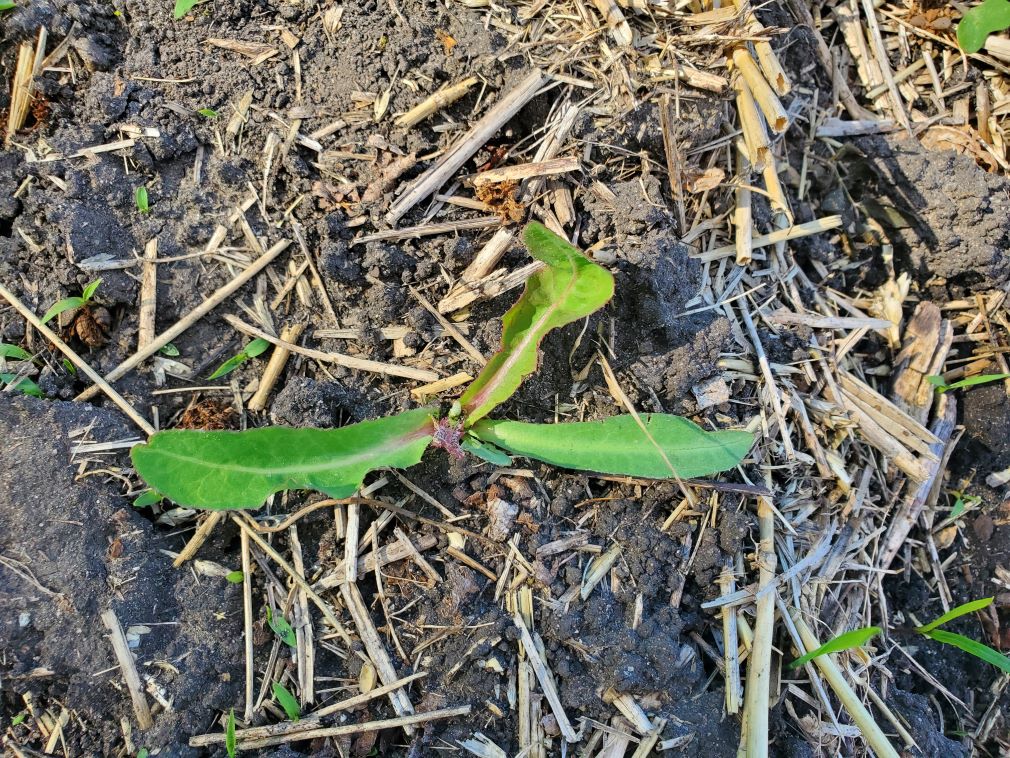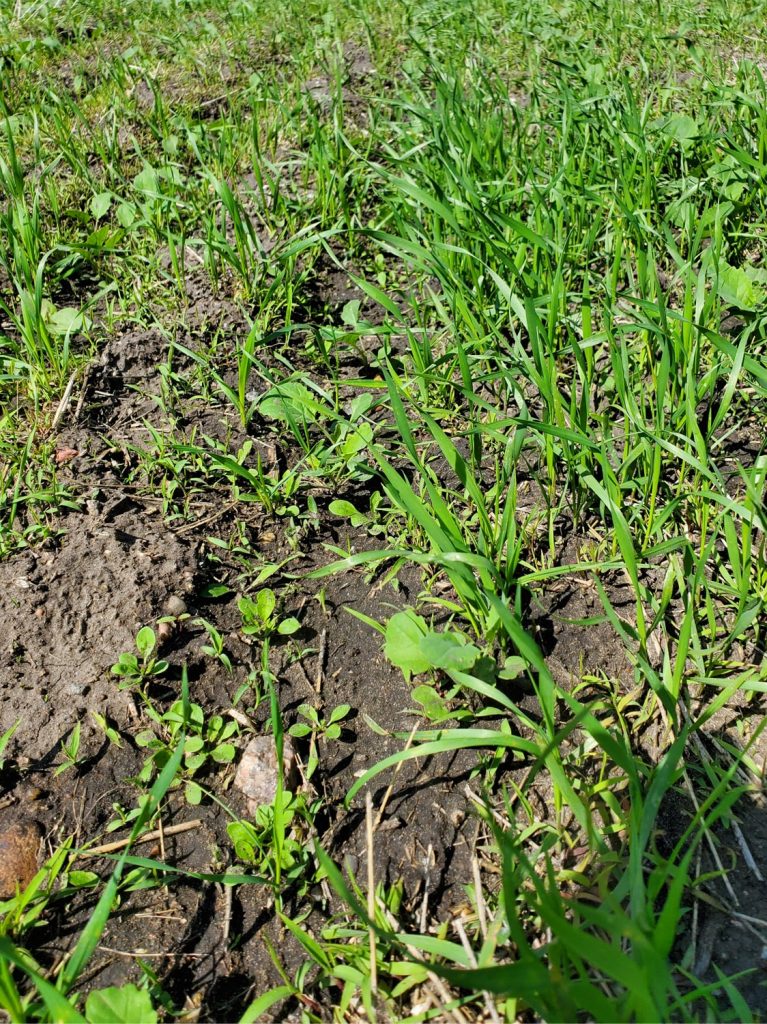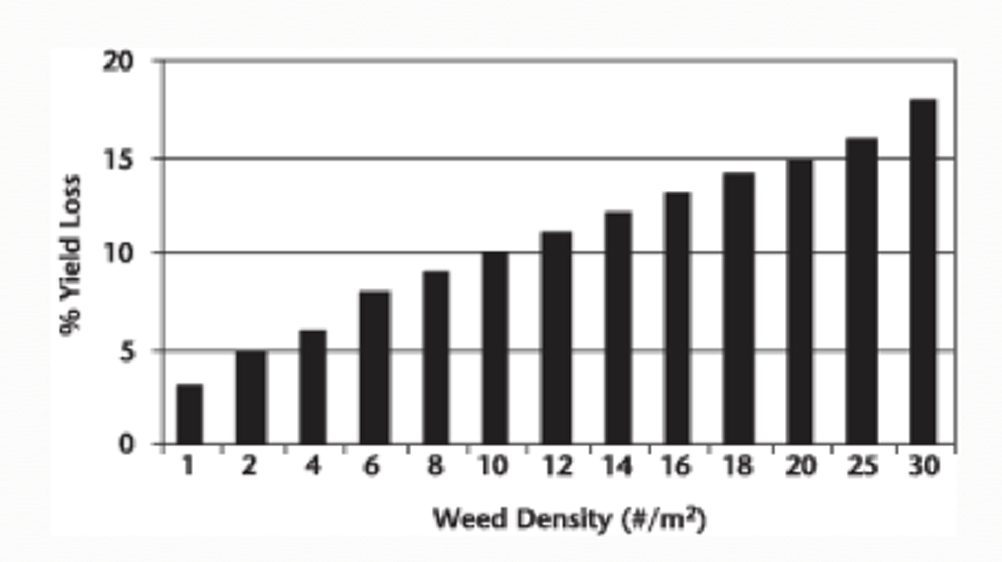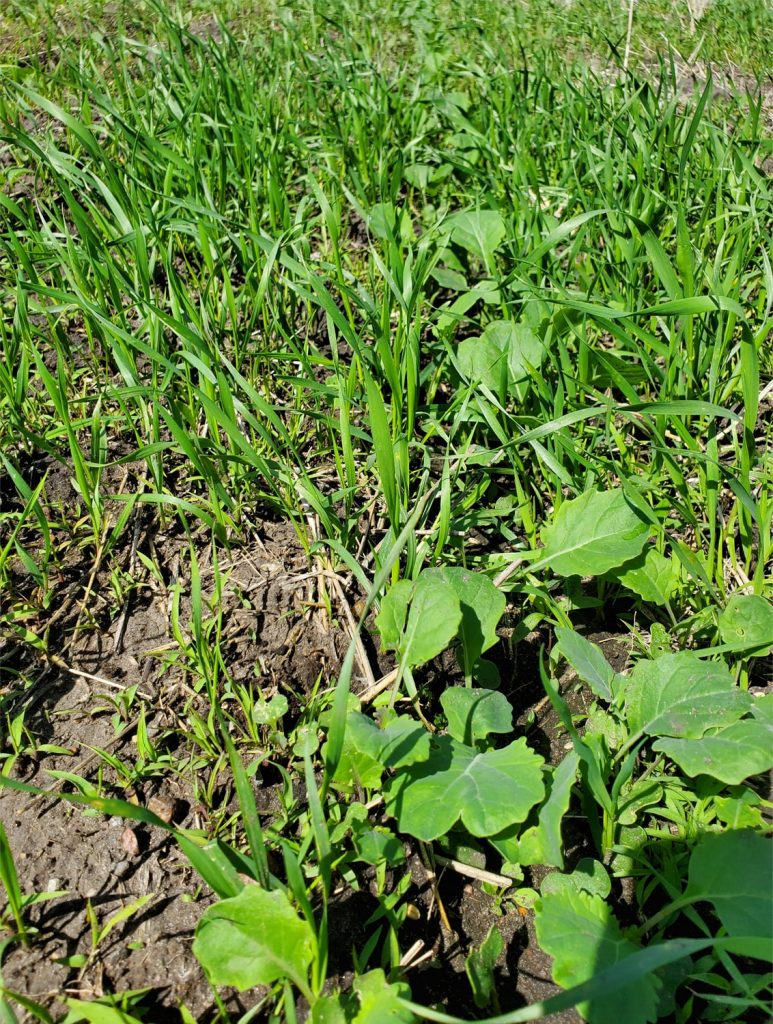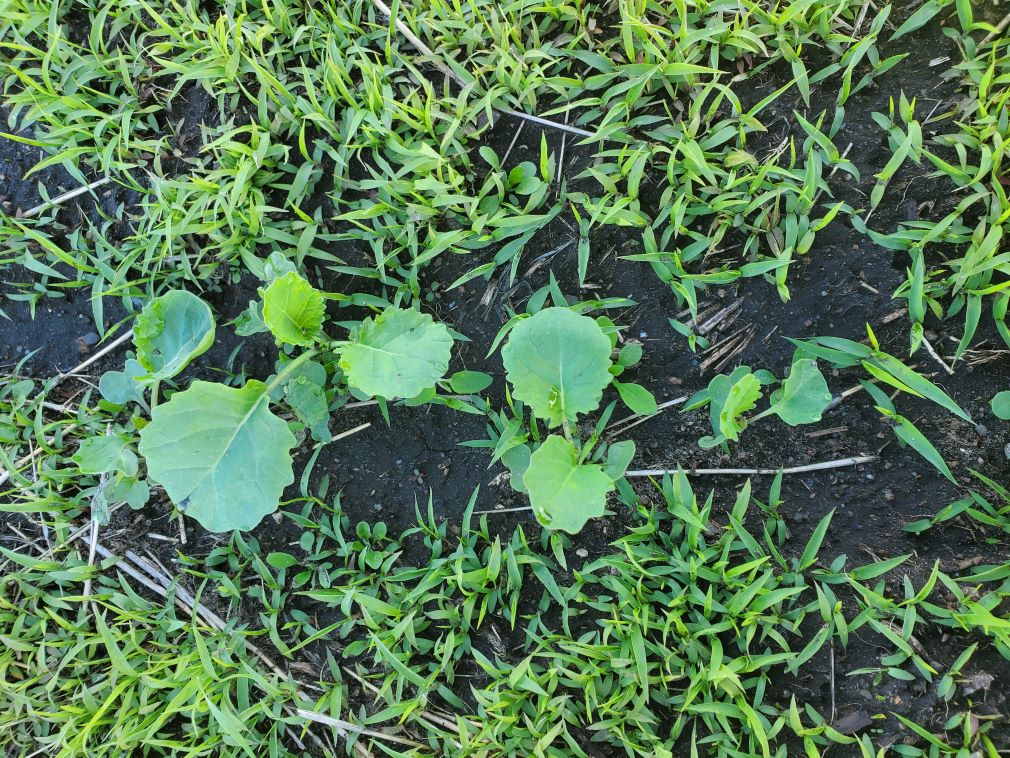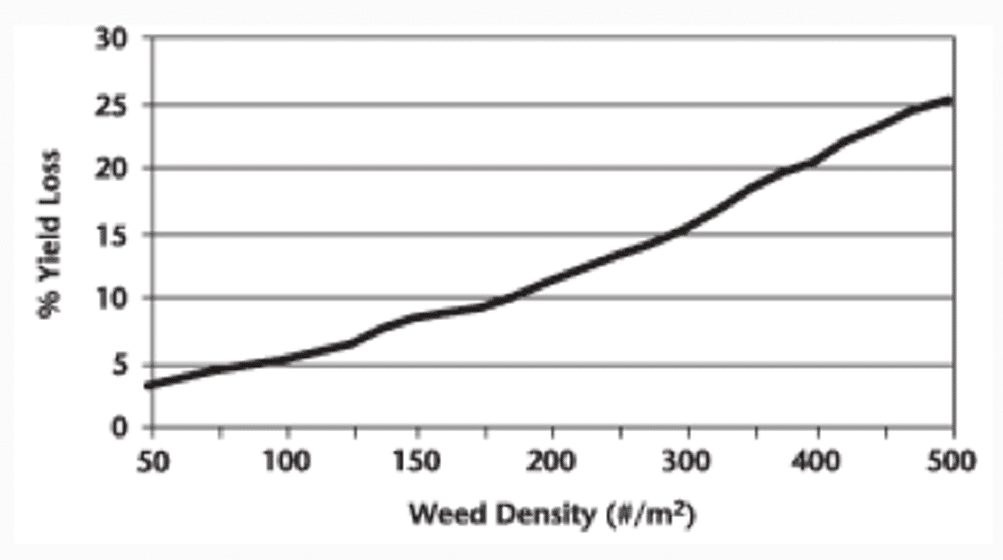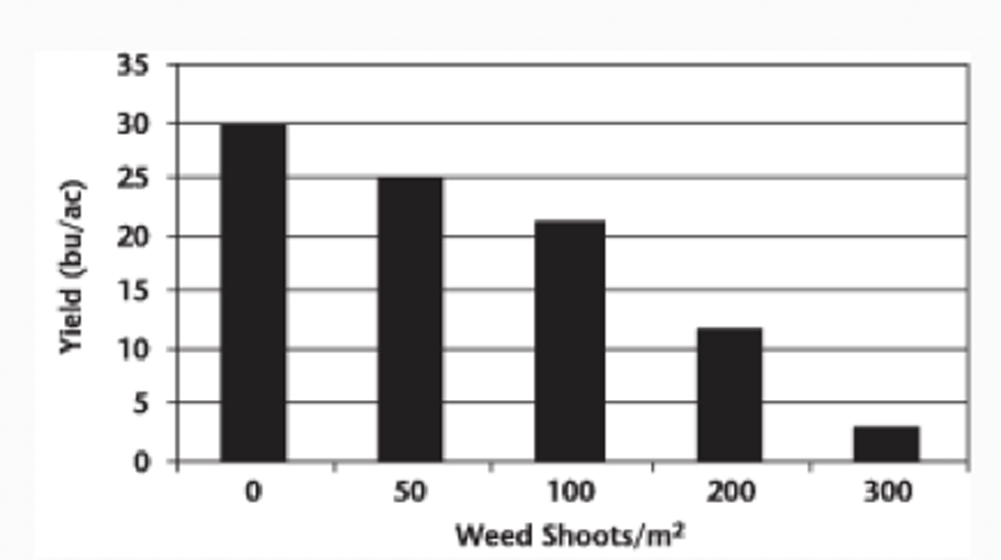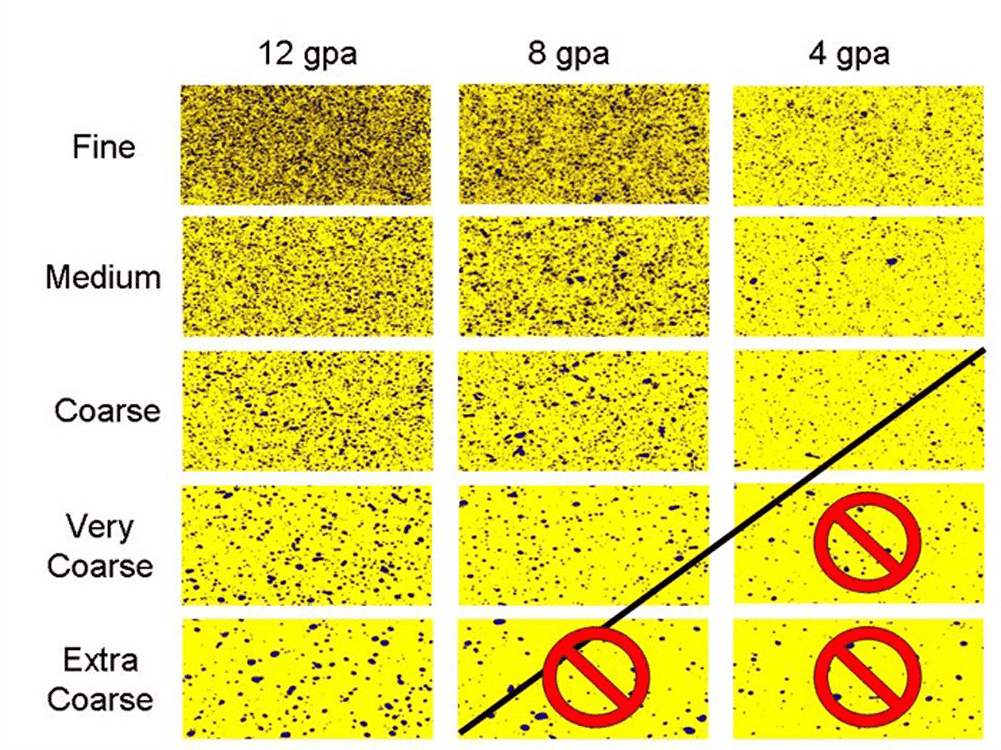Weed control remains one of the most important mechanisms of yield loss in Western Canada. The widespread use of herbicide-resistant canola initially provides a significant improvement to weed control, but environmental challenges, below optimal plant populations, herbicide-resistant weeds and the continued persistence of hard to control weeds (such as cleavers) remain challenges for growers.
Important tips for best weed management
- Early weed control is a critical and can have an economic benefit.
- A combination of preseed weed control and one in-crop application before the four-leaf stage of the crop is often enough. Canola that gets off to a good start with weed competition reduced early in the season rarely sees an economic benefit to a second in-crop application of herbicide.
- Tank mixCombining two or more crop protection products (that are compatible) in one application. More partners are added to preseed glyphosate to improve weed control and reduce selection of herbicide-resistant weeds.
- Use weed control options in rotation crops to target weeds that are harder to manage (such as cleavers and volunteer canola) in wheat.
- Use principles of integrated weed management to reduce the development and build-up of herbicide-resistant weeds, and improve overall results from herbicides.
Overview
Weed management is essential for profitable canola production 1. Of the important requirements for high yield potential, weed management is more important than fertilizer, more important than genetics 2. A meta-analysis of 89 studies from 2003 to 2020 estimated an average of 30 per cent canola yield loss due to weed interference in Canada, with average canola yield losses (weighted by canola harvested area) of 35%, 30%, 18% in Alberta, Saskatchewan and Manitoba, respectively 3.
Weeds can also result in:
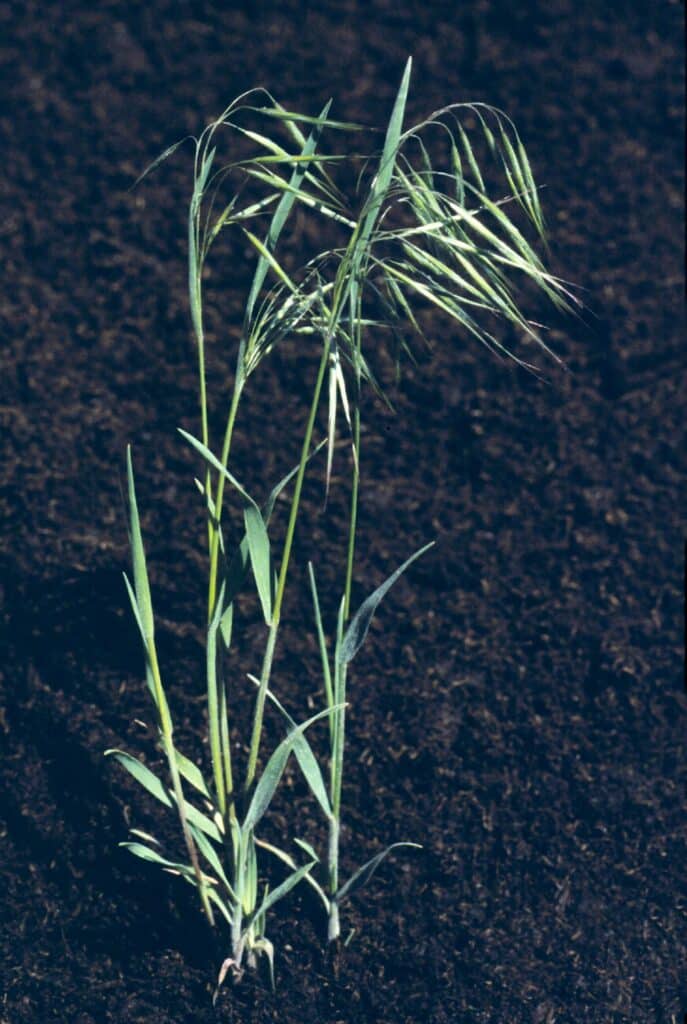
- increased insect and disease damage through multiplication on weed hosts
- spread of more weed seeds
- increased cultivation and/or chemical control practices (as a management strategy)
- reduced seedbed soil moisture and structure as a result of increased tillage to kill weeds prior to seeding
- delayed swathing and combining from swaths that are hard to pick up, resulting in plugging equipment and higher seed moisture content (from increased weed seeds in with harvested grain)
- increased heating and spoilage in storage due to green weed seeds in with harvested grain
- increased dockage with higher cleaning and transportation costs
- contamination resulting in reduced grades and quality from similar inseparable size and shape weed seeds (e.g. cleavers)
Weed competition is generally more damaging when: - low canola plant population lacks vigourSeed properties that determine the potential for rapid uniform emergence and development of normal seedlings under a wide range of field conditions. More
- weed density is high and the weeds are vigorous
- moisture and nutrient supply favours weed growth more than crop growth
- weeds significantly reduce moisture supply to the crop
- weed growth is ahead of the crop
- environmental conditions have resulted in a shallow rooted crop 4
Timing of control
Consider the weeds present and their growth stages when making the spray timing decision. Cleavers, stork’s bill and spiny annual sow thistle have rapid growth rates, and even under cool conditions advance through their leaf stages while other species are delayed. Timing of control is even more critical when these species are present.
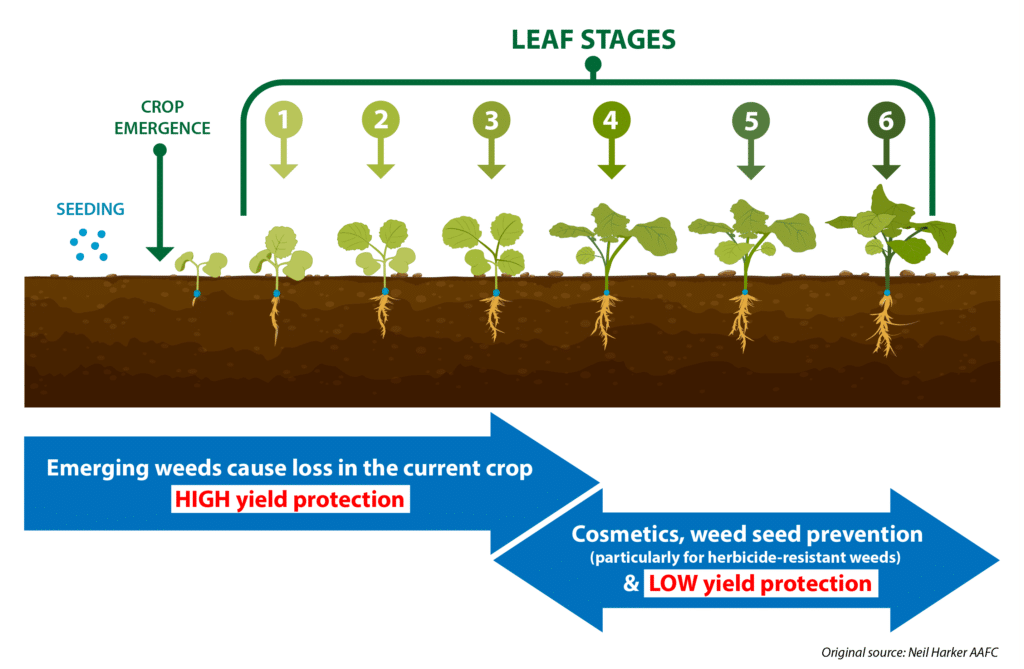
Preseed
Fields with a large population of weeds, especially advancing winter annuals, should get a preseed burnoffRefers to a pre-seed glyphosate (herbicide) application that stunts the growth of the perenial weeds in a field (since glyphosate only affects top growth and isn't taken up by the roots in the spring) in order to give the crop (to be seeding shortly after) a better chance at outcompeting the weeds for sunlight, water and nutrients. More. University of Saskatchewan research shows that where weed competition is significant, an early preseed burnoffRefers to a pre-seed glyphosate (herbicide) application that stunts the growth of the perenial weeds in a field (since glyphosate only affects top growth and isn't taken up by the roots in the spring) in order to give the crop (to be seeding shortly after) a better chance at outcompeting the weeds for sunlight, water and nutrients. More application can have a greater influence on crop yield than an early seeding date. Even if the crop is not seeded until later, an early burnoffRefers to a pre-seed glyphosate (herbicide) application that stunts the growth of the perenial weeds in a field (since glyphosate only affects top growth and isn't taken up by the roots in the spring) in order to give the crop (to be seeding shortly after) a better chance at outcompeting the weeds for sunlight, water and nutrients. More is still preferred. The study found that a late burnoffRefers to a pre-seed glyphosate (herbicide) application that stunts the growth of the perenial weeds in a field (since glyphosate only affects top growth and isn't taken up by the roots in the spring) in order to give the crop (to be seeding shortly after) a better chance at outcompeting the weeds for sunlight, water and nutrients. More treatment yielded significantly lower than early treatment, regardless of when the plots were eventually seeded 5.
For weed control options, check the annual provincial publication for current recommendations and always refer to product labels.
- Alberta Crop protection Guide (The Blue Book)
- Saskatchewan Guide to Crop Protection
- Manitoba Guide to Field Crop Protection
- Ontario Crop Protection Hub
Preseed spraying with phenoxy herbicides is not recommended as serious damage to the emerging canola seedlings can occur. Preseed ahead of cereals offers more herbicide options, including phenoxy herbicides.
Winter annual weeds like flixweed, shepherd’s purse, narrow-leaved hawk’s-beard and stinkweed can remove a lot of soil moisture in the spring as they begin to grow very early and are very inefficient water users. Early preseed burnoffRefers to a pre-seed glyphosate (herbicide) application that stunts the growth of the perenial weeds in a field (since glyphosate only affects top growth and isn't taken up by the roots in the spring) in order to give the crop (to be seeding shortly after) a better chance at outcompeting the weeds for sunlight, water and nutrients. More stops this uptake, preserving moisture and nutrients for the crop.
How long to wait between spraying and seeding: For annuals and winter annuals, glyphosate needs only 24 hours to get to the growing point and set the control process in motion. (It may be quicker than that for some specialty glyphosates in good growing conditions.) After a day, the crop can be seeded. For perennial weeds, the recommended delay ranges from three to five days depending on weather conditions. If sunny and warm, translocation will take place fairly quickly so three days should be enough. If weather is cloudy and/or cool when applied, delaying five days is recommended before seeding. When deciding how long to wait to seed, remember that the conditions on the day the glyphosate is applied are the most important to efficacy, making them relatively more important than conditions in the days that follow.
Post-seeding/pre-emergence spray window
Preseed burnoffRefers to a pre-seed glyphosate (herbicide) application that stunts the growth of the perenial weeds in a field (since glyphosate only affects top growth and isn't taken up by the roots in the spring) in order to give the crop (to be seeding shortly after) a better chance at outcompeting the weeds for sunlight, water and nutrients. More also reduces risk if weather causes a delay in post-emergence application. Weeds present when the crop emerges will have a substantially greater negative impact on the yield of the crop if the pre-emergent application is missed altogether.
The cleaner you have the field as canola emerges from the ground, the better. If preseed burnoffRefers to a pre-seed glyphosate (herbicide) application that stunts the growth of the perenial weeds in a field (since glyphosate only affects top growth and isn't taken up by the roots in the spring) in order to give the crop (to be seeding shortly after) a better chance at outcompeting the weeds for sunlight, water and nutrients. More is missed, one option is to apply glyphosate or (glyphosate with a tank mixCombining two or more crop protection products (that are compatible) in one application. More partner) post seeding and pre-emergence. This can be a narrow window. Shallow seeded canola can emerge within five days under warm and generally moist soil conditions, and since growers need to leave weeds for a couple days to start growing again after the seeding operation, the window for post-seed/pre-emergence spraying is very narrow. The time lag between seeding and spraying is necessary to allow weeds buried by the seeding operation to re-emerge and to allow weeds uprooted to overcome the stress placed on them. However, spraying and missing a few of these weeds is more beneficial than waiting to spray in-crop. Ensure to check for crop emergence before applying products that need to be applied pre-emergence.

Post-emergence
Benefits of early weed removal, from the one- to four-leaf stages of the canola crop, are supported by numerous research studies across Western Canada 6, 7, 8, 9, 10, 11. This early control allows the crop to get established, and controls early emerging weeds before they take up excessive nutrients and moisture. Also, weeds that emerge after the crop has reached the four-leaf stage are usually so far behind the crop that they will have little impact on yield, and contribute very little to the weed seedbank.
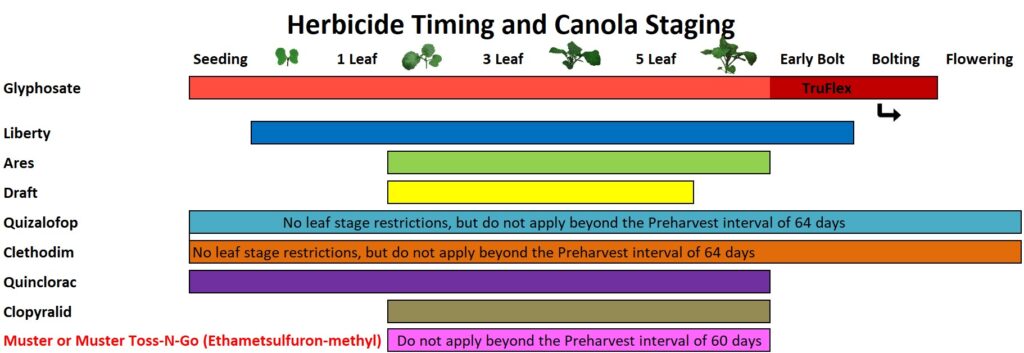
Waiting a few extra days means that more late-germinating weeds may be up and controllable, but these studies show that this strategy does not translate into yield. This Canola growers survey reported that growers spraying their first in-crop herbicide application at the 1-leaf or 2-leaf stages had higher yields than those spraying earlier or later 12. This is the case across herbicide systems, according to research demonstration plots in Swift Current that reported higher yields amongst early herbicide application timings, regardless of which system was used 13).
Once the canopy has closed, the crop should outcompete the weeds all on its own. Second in-crop applications at this time do not usually provide an economic benefit as the plants are competitive enough on their own in comparison to the weeds, but can in some cases reduce weed seeds entering the soil seed bank.
For perennial weeds that have escaped preseed and first post-emergence applications but are delayed relative to the crop, pre- or post-harvest glyphosate applications may be a better alternative than a second post-emergence spray, especially if the weeds are delayed enough to avoid seed set prior to swathing. Although this can be a balancing act as well.

The Canola Council of Canada ran weed removal timing trials across Western Canada in 1998, 1999, 2000 at Crop Production Centres. Large plots were sprayed for weeds at the 1 to 2-leaf stage of the crop (early), the 3 to 5-leaf stage (mid) and at the 6 plus leaf stage (late). In some years, the mid timing was missed or not included in the trials. In some years, two broader timings were used as opposed to three narrower timings. At 24 out of 27 site years, the earliest timing gave the best yield. The early applications showed a 16 per cent yield advantage compared to the latest timing.
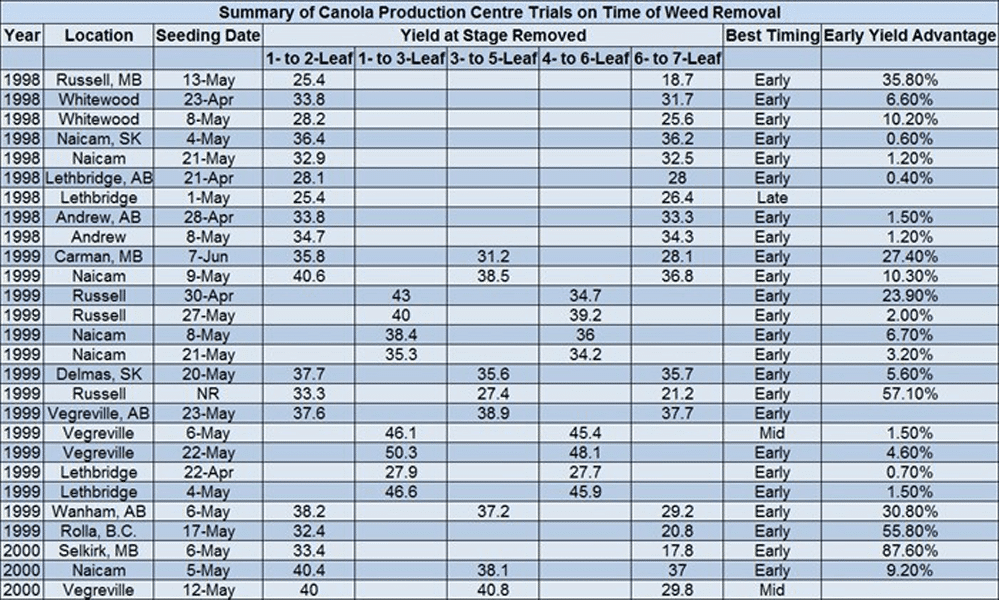
A field-scale time of weed removal in canola study conducted at 10 western Canada canola fields in 1999 and 2000 also concluded that canola growers are well advised to ensure weed removal at relatively early growth stages. Delaying weed removal until the 6- to 7-leaf stage reduced canola yields in this study by 20 percent. See two versions of the related ‘Time of weed removal’ graphs for details.

The following table from the Guide to Crop Protection (from the Saskatchewan Ministry of Agriculture) provides weed control options for canola.
Weed control options for canola
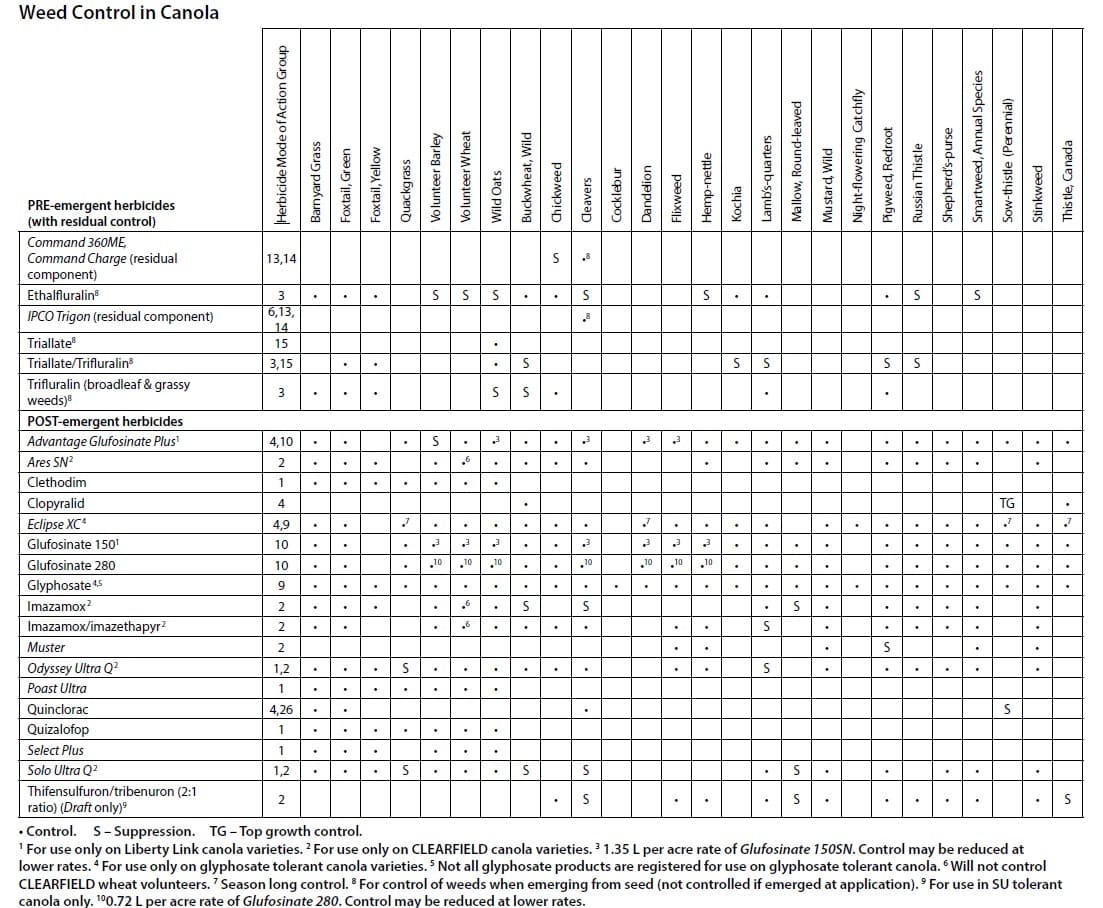
Always follow labels when applying herbicides. Applications made after the label window can lead to reduced weed control due to advanced weed staging and reduced herbicide contact with the weeds through the increased canola canopy closure. Late applications can also cause canola buds to abort, increasing the potential for permanent yield loss. Finally, late applications and higher than recommended rates of registered herbicides can increase the risk of elevated residues in the marketable grain. Foreign buyers are testing for pesticide residues that exceed registered maximum residue limitsThe greatest amount of a particular residue (ex. pesticide residue) that is allowed to be found in a sample (ex. of a canola shipment). More (MRLs) or are not registered at all.
An eight site-year study (2010-2012) with locations in Alberta (St. Albert/Edmonton, Lacombe and Lethbridge) and Saskatchewan (Saskatoon) reported that late herbicide applications impacted crop yield, yield components, and even seed quality, emphasizing the benefit of following product labels. At the time of this study (prior to TruFlex and Optimum GLY canola) the glyphosate-resistant (Roundup Ready) system appeared to be impacted more significantly than either the glufosinate-resistant (LibertyLink) or imidazolinone (Clearfield) systems. So, while unfavourable weather or circumstances can sometime prevent early application options, the perceived crop yield loss from emerged weeds has to be considered against the potential reductions in yield from late herbicide applications 14.
Yield loss from late herbicide applications vary on a field by field basis depending on herbicide rate, overall health of the field, and growing conditions during and after the application. Canola under any type of existing stress will likely have greater losses from a late herbicide application. It simply won’t be able to recover as quickly. If canola is healthy at the time of spraying but conditions are hot and dry soon afterward, canola may not be able to compensate by adding more flowers later in the flowering period. Losses cannot be predicted, but they could be up to 30 per cent, and even more in overlap areas.
Aerial options for weed control
If weeds and crop are advancing toward the end of the application window and the ground is too soft and wet to support a sprayer, then aerial spraying may be the best economic response. Here are the options for aerial herbicide application in canola:
- Roundup WeatherMax is the only glyphosate registered for aerial application at this crop stage, but use is subject to certain conditions which are outlined in detail on the label. (Many others are registered for pre-harvest.) In season sometimes other glyphosate products will get emergency use aerial registry so speak to your aerial applicator about your options.
- Liberty (glufosinate) is registered for aerial application at this stage. Remember, Liberty works best at higher water volumes. Clethodim is also registered for aerial application.
- None of the Clearfield herbicide system products are registered for aerial application on Clearfield canola. However you can still use the clethodim products on the Clearfield System for a grassy weed control option.
- Draft does not have an aerial label
- Assure II, Equinox and Poast have aerial labels.
- Quinclorac does not have an aerial label.
For more on these requirements, read product labels and the provincial guides to crop protection.
Benefits of aerial application: If weeds are plentiful, at the same stage or ahead of the crop, and canola canopy closure is unlikely to effectively limit their growth, then it will probably pay to control these weeds by air if you have no other option. Aerial spraying also avoids wear and tear on sprayers and on the field when conditions are wet. Under these very wet conditions, ground sprayers can leave deeps ruts to contend with in subsequent spray applications and at harvest, while destroying the crop in those tracks. Getting a sprayer unstuck can be a long, messy job, and dealing with the ruts at harvest can be time consuming and annoying.
Downsides to aerial application: Buffer zone requirements for aerial application are substantially further from sensitive habitats than buffers for ground application. For Liberty, for example, the buffer zone for aerial application is 30 metres from non-target plants and animals compared to a one metre buffer for ground application. Aerial application also represents another cost, although there is not that much additional cost now between aerial and ground application when you are hiring a custom applicator. Before applying by air, know what crops are surrounding the field to the N, NE, E, SE, S, SW, W, NW. Note what herbicide system is used in neighbouring canola crops as well. The aerial applicator will need all of this information.
Fall
Fall is a good time to clean up weeds, especially winter annuals and perennials. Cold temperatures help trigger winter annuals and perennials to start moving food reserves down into below ground tissues, so waiting until after cooler weather may improve results. When you spray at this time the glyphosate gets translocated down into the root system and so you get better control of these hard to kill weeds. Refer to your provincial guide to crop protection to determine which rate of glyphosate will work best for you.
For notes and recommendations on herbicides registered for use in the fall on land planned for canola, see the Fall-applied herbicides for fields planned for canola table in the Canola Watch Fundamentals Fall weed control article.
When applying in the fall:
- Make sure the plants are actively growing with new supple leaf area to target. Six inches of growth is a rough guide. Weeds cut off at harvest need time to accumulate new leaf tissue. This is essential for herbicide uptake and efficacy.
- Frost damaged leaves may look green but they’re not healthy and will not take up herbicide. If frost has occurred, avoid application until leaf condition of the target weeds can be evaluated. Leaf tissues that are blackened, browned or dark green yet brittle are all symptoms of cold temperature damage. Leaves should be vibrant green, shiny and pliable. Look for new growth. That means the weed is actively growing again and will take in the herbicide.
- Spray in the afternoons when temperatures are warmer and heavy dew is off the plant. Ideally, you want to apply when temperatures are above 10 degrees Celsius and rising on days with predicted highs above 15 degrees Celsius, but preferably higher. If applying on days where temperatures are at the minimum, bright sunshine is critical. Bright sunny conditions are ideal for moving herbicides to the roots where they will have the most impact next year. Check product labels for specific recommendations as temperature requirements may vary.
- Use products registered for use before canola in fields that are planned for canola the following spring.
- Know whether the weeds present in the fall will last the winter. Canola volunteers, for example, that emerge in the fall are unlikely to last the winter and do not need to be sprayed. In fields where crops were harvested prior to mid-August, annual weeds growing back from below the cut may have a good chance of producing significant additional seed prior to a killing frost. These annual weeds may benefit from mowing or spraying.
Ideally, growers will adopt an integrated weed management program to reduce the reliance on herbicides for weed control.
Integrated weed management
Integrated weed management (IWM) combines different agronomic practices to reduce the reliance on any one weed control technique. Controlling weeds with only one or two techniques gives weeds the chance to adapt to those practices. Adopting IWM practices early is key, because the alternative of waiting until herbicide-resistant weeds become established could result in a much more challenging situation 15. Many examples of herbicide-resistant weeds exist on the Prairies, including cleavers with Group 2 resistance, kochia with Group 2 and Group 9 resistance, and wild oats and green foxtail with Group 1 resistance.
Herbicide-resistant weeds
Herbicide-resistant weeds are becoming more common across the Prairies. Growers and agronomy providers view them as agronomic and economic threats to canola production 16,17.
Kochia and cleavers are widely resistant to Group 2 herbicides. Kochia with resistance to Group 9 herbicide was detected on the Prairies in 2011. Group 1 resistant wild oats are in many fields. There are other examples 18. The following table depicts the herbicide-resistant weeds in Western Canada. 19)
Herbicide-resistant weeds in Western Canada
*Multiple combinations of
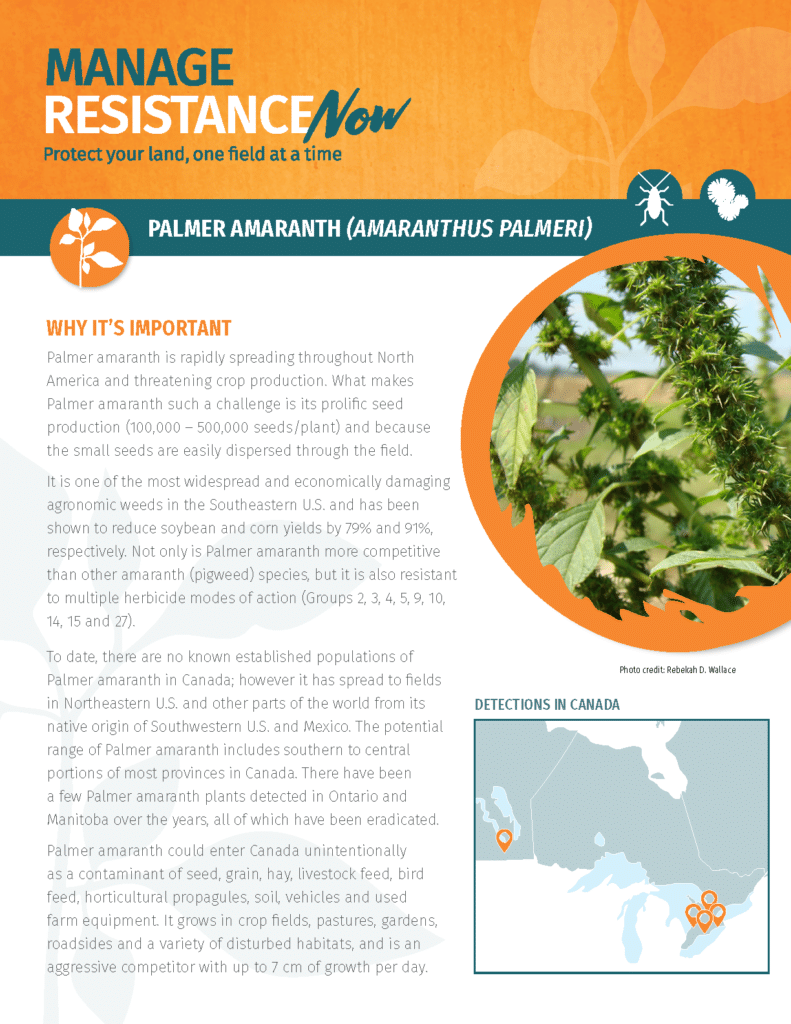
Herbicide-resistant weeds in Western Canada (Table 10 from the Saskatchewan Ministry of Agriculture’s 2025 Guide to Crop Protection
To reduce the risk of selecting for resistant weeds on your farm:
- Control weeds early. Herbicides are more effective on small weeds.
- Rotate herbicide groups.
- Rotate with crops that allow for a wide range of herbicide groups, and that have different seeding and harvest timing (ex. winter cereals.)
- Use tank mixes. Hitting weeds with two modes of action reduces the risk of herbicide-resistant weeds escaping and setting seed.
- Use the right herbicide at the right rate and apply at the right time. Cutting rates, for example, may reduce herbicide efficacy and increase weed seed return to the soil seed bank.
- Control weeds throughout the season to reduce the weed seed bank.
- Employ other integrated weed management practices so herbicides are not the only method of weed management used on the farm.
As noted in the mitigating herbicide resistance – investigating novel integrated weed management systems study, early application of IWM can be key to effectiveness because waiting until resistance establishes (and densities increase) could result in management failure and loss of control.
For information on managing herbicide resistance in canola and other crops, see CropLife Canada’s Manage Resistance Now.
Integrated weed management practices
IWM employs a range of control practices to keep weeds “off balance” and keep weed populations at manageable levels. Weeds are less able to adapt to a constantly changing system that uses many different management practices. Practices that limit the introduction and spread of weeds include:
- diverse rotations
- higher seeding rates
- varied seeding dates
- shallow seeding depth
- narrow row spacing
- use of pedigreed seed
- tillage or direct seeding
- adequate fertility
- insect and disease protection
- preventative measures
- chemical control measures
- harvest weed seed control
Diverse rotations
Crop rotations or crop sequences that include oilseeds, spring cereals, winter cereals, pulses and forage crops allow the use of different herbicides and cultural practices that make it difficult for weeds to adapt and build up. Crop rotations must take advantage of crop life cycle and weaknesses in the life cycle of the existing weed problem.
Certain crop varieties are more competitive than others. Varieties that cover the ground more rapidly and close their crop canopy earlier can help shade out weeds. More vigorous growing canola hybrids sown at a higher plant population are very competitive and result in reduced weed growth and lower dockage.
Higher seeding rates
Higher plant populations allow the crop to shade weeds and make it more difficult for weeds to access nutrients and water. Canola crops that close the canopy quickly may only require one in-crop herbicide spray compared to less dense (thin) crops, which may require two applications. In most cases, seeding rates can be moderately increased to obtain weed management benefits without significant negative consequences.
Varied seeding dates
While most crops in a rotation benefit from early seeding it can be beneficial on individual fields to vary the seeding date from year-to-year. Early-seeded canola can result in the crop emerging before the weeds. Some weeds like green foxtail, lamb’s-quarters, kochia, redroot pigweed and Russian thistle require more growing degree days to germinate and emerge. An early-seeded canola crop could emerge far enough ahead of these weeds that herbicides may not be required. However, cool season weeds like wild oats, quackgrass, wild mustard and stinkweed may present a problem with early seeding.
In certain situations, later seeding may be used to reduce the number of weeds in the crop. Shallow till the soil early in the spring to aerate it and promote weed seed germination. Delay seeding until weed growth has reached a maximum. This growth must be destroyed either by a preseed herbicide application or a tillage operation prior to seeding. Disadvantages of this approach are that tillage can cause the loss of surface soil moisture resulting in poor, uneven germination and emergence, and that delayed seeding may reduce crop yield.
Shallow seeding depth
Seeding at one to 2.5 centimetres (one inch), provided adequate moisture is present, means quicker seedling emergence which helps the crop get ahead of or keep up with the weeds. Deep seeding delays crop emergence and weakens seedlings and they are less competitive.
Narrow row spacing
Narrow row spacing allows plants to be more competitive. Research at the Agriculture and Agri-Food CanadaAgriculture and Agri-Food Canada is a department of the Government of Canada. More (AAFCAgriculture and Agri-Food Canada is a department of the Government of Canada. More) research centre in Scott, Saskatchewan showed that weed biomass increased and canola yields decreased with wider row spacing 20.
The trend is to use wider row spacings, which has advantages for residue clearance and lower equipment cost per foot. Herbicide tolerant varieties also make weed control more effective with wider rows. However, narrower rows canopy faster to improve crop competition, which can reduce the risk of weeds adapting to these systems.
Use of pedigreed seed
Choose varieties that are very competitive in growth habit. Choose a varietyA variety is a variant of a species that evolved in nature without the intervention of humans, e.g. Brassica oleracea variety (in short form, var.) botrytis (cauliflower), var. capitata (cabbage), var. italica (broccoli), etc. More with a herbicide resistance that will be effective on the weeds/volunteers in your field.
Tillage or direct seedingA seeding method where the crop is sown into the field without any previous spring tillage operations. More
Seedbed preparation can affect crop and weed growth. Spring tillage to control weeds can also loosen the seedbed and, in moist conditions, create clods — two conditions that reduce seedbed quality and hurt canola emergence.
Research at the AAFCAgriculture and Agri-Food Canada is a department of the Government of Canada. More research centre in Indian Head, Saskatchewan found that soil disturbances from tillage increased weed densities. The research also found that weed densities early in the season were lower than at the end of the seeding season. Direct seedingA seeding method where the crop is sown into the field without any previous spring tillage operations. More using a burnoffRefers to a pre-seed glyphosate (herbicide) application that stunts the growth of the perenial weeds in a field (since glyphosate only affects top growth and isn't taken up by the roots in the spring) in order to give the crop (to be seeding shortly after) a better chance at outcompeting the weeds for sunlight, water and nutrients. More treatment may be all that is required to control weeds, especially at later seeding dates. This is possible because a tillage operation that encourages a new flush of weeds within the crop is eliminated.
Direct seedingA seeding method where the crop is sown into the field without any previous spring tillage operations. More systems leave crop residue between rows, which shades the soil and keeps it cool. For this reason, weed emergence can be slower in direct seedingA seeding method where the crop is sown into the field without any previous spring tillage operations. More. A second flush of weeds is less likely to occur because of higher stubble residue between crop rows. Green foxtail is an example of one weed species that is reduced in a direct seeded soil.
For growers who use tillage for weed control, fall may be the better time ahead of canola crops. This timing reduces the stubble stand that traps snow and reduces soil erosion. However fall timing provides mechanical weed control while giving the soil time to resettle, allowing for improved seed placement and seed to soil contact the following spring. Some fall tillage considerations are listed below:
- Shallow cultivation in the fall, resulting in a light soilA soil that is high in sand content. More covering of weed seeds, is the most effective means of stimulating wild oats germination. Harrowing is relatively ineffective as it does not provide a sufficient soil cover to favour germination.
- Deeper tillage penetration may be required to destroy roots of perennial weeds such as Canada thistle and quackgrass. Deeper tillage may also be required to prepare the soil for soil-incorporated herbicides or fertilizers, and to bury some of the straw.
- Deep fall tillage buries weed seeds deeper and induces dormancy in wild oats and other smaller weed seeds. Small weed seeds with a long dormancy period (wild mustard and stinkweed) most readily lose dormancy when left on the soil surface. Deep fall tillage can also induce dormancy in volunteer canola.
- Fall spraying is more effective than tillage for winter annuals like stinkweed, flixweed, tansy mustard, groundsel, and winter annual cleavers, which do not germinate until late September or October. These weeds germinate, establish a root system and form a rosette that is not killed by winter frosts. The plants overwinter and continue to grow as soon as snow disappears in the spring. By the time fields can be worked in the spring, these weeds have often become well-established and hard to kill, requiring extra tillage that dries out the seedbed. These weeds can be more effectively controlled by late fall spraying than with tillage. Tillage often transplants the weeds, allowing them to grow.
Adequate fertility
Banding nitrogen fertilizer gives seedlings an advantage over the weeds in accessing the nitrogen in the early stages. Most weeds germinate near the soil surface, therefore, banded fertilizer is not as accessible to the weeds, reducing the number of weeds germinating and their seedling vigourSeed properties that determine the potential for rapid uniform emergence and development of normal seedlings under a wide range of field conditions. More. Broadcast nitrogen, especially if it’s incorporated, can stimulate weed seed germination (especially wild oats) and is more readily available to weed seedlings. Phosphorous fertilizer with the seed, especially when early seeding, is essential for establishing vigorous seedlings. Apply safe levels of nitrogen, phosphorus and potassium with the seed to avoid killing or injuring seedlings, making the stand less competitive.
Insect and disease protection
Seed treatments combined with shallow seeding into a firm, moist seedbed may reduce seedling diseases, allowing plants to be more competitive with weeds. Protection from insects such as the flea beetle will enhance seedling vigourSeed properties that determine the potential for rapid uniform emergence and development of normal seedlings under a wide range of field conditions. More and growth.
Prevention measures:
- Ensure that farm equipment is clean so that weeds are not spread from field-to-field or from one farm to another.
- Cover screenings and grain during transport.
- Restrict domestic animal movement from weedy fields to clean fields.
- Do not allow weeds to set seed.
- Control weeds in ditches, field edges and around sloughs.
- Disrupt or destroy weeds by machine, hand mowing, hand pulling of small patches, early harvest, tillage, grazing, ensiling, burning weeds prior to maturity and mulching small patches with clean straw, manure or plastic.
- Control the spread of weeds through manure by proper rotting or composting of the manure and livestock bedding.
- Control or restrict wind and water movement from weedy to weed-free areas.
Chemical control measures
From an IWM standpoint, use herbicides in combination with good agronomic practices. Focus on combinations of optimal agronomic factors that enhance crop health and competitiveness, favour viable weed management systems, and support integrated crop management practices. AAFCAgriculture and Agri-Food Canada is a department of the Government of Canada. More research found that combining the best varietyA variety is a variant of a species that evolved in nature without the intervention of humans, e.g. Brassica oleracea variety (in short form, var.) botrytis (cauliflower), var. capitata (cabbage), var. italica (broccoli), etc. More, the highest seeding rate and the earliest weed removal treatment increased yield 41per cent compared to the combination of a less vigorous varietyA variety is a variant of a species that evolved in nature without the intervention of humans, e.g. Brassica oleracea variety (in short form, var.) botrytis (cauliflower), var. capitata (cabbage), var. italica (broccoli), etc. More, the lowest seeding rate and the latest time of weed removal 21.
Choose herbicides based on the type of weeds and the tolerance of the crop to various herbicides. Apply the right herbicide in the proper way, at the optimum time and in the recommended concentration. This information can be obtained from the label on the herbicide container, and from public or private crop specialists. Since registrations change from year to year, obtain provincial herbicide guidelines annually. Check the annual provincial publication for current recommendations and always refer to product labels.
Alberta Crop protection Guide (The Blue Book)
Saskatchewan Guide to Crop Protection
Manitoba Guide to Field Crop Protection
Harvest weed seed control
Two options for integrated weed management at harvest are: seed crushers added to the back end of combines and modifications to chaff-spread patterns. These practices can help manage herbicide-resistant weeds and protect herbicides that are currently used from losing their effectiveness.
This weed management podcast provides additional information.
Herbicide-tolerant canola systems
The herbicide-tolerant (HT) systems in canola are:
- Clearfield – canola resistant to imidazolinone chemistry (Odyssey, Absolute, Solo, Ares, Tensile)
- Sulfonylurea-tolerant canola (Draft)
- LibertyLink – canola resistant to glufosinate ammonium (Liberty)
- Roundup Ready – canola resistant to glyphosate (Roundup)
There are also some varieties that offer a stacked trait with herbicide tolerance to both glyphosate and glufosinate ammonium.
The main features of each weed control system are summarized below.
Clearfield
- Clearfield products and registered tank mixes can be applied to Clearfield varieties.
- Controls various annual grassy and broadleaf weeds using post-emergent applications.
- Extended control (residual) herbicides offer control of some second flushes of certain shallow germinating weeds.
- Systemic mode of action with affected weeds showing stunting, yellowing/reddening within three to 10 days of spraying.
- Products with the same mode of action (Group 2) will not control volunteer Clearfield canola in subsequent years. Products may be co-packaged with a Group 1 or Group 4 product.
- Allows weed resistance management by switching from a Group 1 to a Group 2 herbicide or using a co-packaged product Group 2 and 4 or Group 2 and 1. Broadleaf resistance is a concern, especially on fields with previous Group 2 use.
- Some restrictions for recropping in the year following application.
- None of the Clearfield herbicide system products registered for aerial application on Clearfield canola.
Sulfonylurea-tolerant
- Draft and registered tank mixes can be applied to Sulfonylurea-tolerant varieties.
- Controls various annual grassy (when tank mixed with a group 1) and broadleaf weeds using post-emergent applications.
- Extended control (residual) herbicides offer control of some second flushes of certain shallow germinating weeds.
- Systemic mode of action with affected weeds showing stunting, yellowing/reddening within three to 10 days of spraying.
- Products with the same mode of action (Group 2) will not control volunteer canola in subsequent years. Products may be co-packaged with a Group 1 or Group 4 product.
- Broadleaf resistance is a concern, especially on fields with previous Group 2 use.
- Some restrictions for recropping in the year following application.
- Draft is not registered for aerial application on Clearfield canola.
LibertyLink
- Liberty herbicide and registered mixes can be applied to LibertyLink varieties.
- Controls various annual grassy and broadleaf weeds, and suppresses some perennial weed species.
- Liberty works best when applied with water volumes a minimum of 10 gallons per acre.
- Applied post-emergent. Activity is through contact with green tissue, with affected plants show burning/yellowing within two to five days after application. Plants die one to two weeks after treatment.
- Unique mode of action (Group 10) and can be tank mixed with Group 1 clethodim, quizalofop and Group 4 quinclorac. Good option for grassy and broadleaf weed resistance management.
- No restrictions on recropping in the year following application.
- Liberty works best on warm sunny days. On cloudy days, increase water volumes and consider spraying later in the day when temperatures are at their highest.
- Liberty is registered for aerial application. Centurion and Select are also registered for aerial application.
- Avoid spraying Liberty when temperatures are above 28 degrees Celsius as canola injury can occur.
Roundup Ready
- Glyphosate and registered mixes can be applied to Roundup Ready varieties.
- Registered glyphosate rates and the application window are different for TruFlex or OPTIMUM GLY varieties.
- Controls various annual grassy and broadleaf weeds, and controls or suppresses some perennial weed species.
- Applied post-emergent. Activity is systemic, with affected weeds showing yellowing at the terminal buds within seven to 10 days after application.
- Glyphosate will not control volunteer Roundup Ready canola in subsequent years. An additive must be included with glyphosate to control the volunteers.
- Unique mode of action (Group 9), good option for grassy and broadleaf weed resistance management for Groups 1, 2, 3 and 8. Can be tank mixed with quinclorac.
- No recropping restrictions in the year after application.
- Roundup WeatherMax is the only glyphosate registered for aerial application at the post-emergence crop stage, but use is subject to certain conditions which are outlined in detail on the label. (Many others are registered for pre-harvest.)
How to choose an HT system
Consider management goals when picking an HT canola. Growers may find one HT system the best choice for some fields and another HT system the best choice for other fields.
Use weed spectrum to narrow the choice. Choose the product that matches the most important weeds in a particular field. Consider herbicide cost, too. Ordering early or in a company program may reduce costs.
List the other non-weed factors. These include varietyA variety is a variant of a species that evolved in nature without the intervention of humans, e.g. Brassica oleracea variety (in short form, var.) botrytis (cauliflower), var. capitata (cabbage), var. italica (broccoli), etc. More performance, harvestability, and disease resistance. However, these factors must not take priority away from the weed control issue. Do not put a great performing varietyA variety is a variant of a species that evolved in nature without the intervention of humans, e.g. Brassica oleracea variety (in short form, var.) botrytis (cauliflower), var. capitata (cabbage), var. italica (broccoli), etc. More into a field with a weed infestation that the available herbicide for the system will not control.
How to manage volunteer canola
Volunteer canola is a weed and competes with the crop for nutrients and water and sunlight. Volunteers in a canola crop do not make a positive contribution to yield. Volunteers do not have seed treatment, so they can introduce seedling diseases and increase flea beetle pressure. Also, volunteers in non-canola years provide a host for blackleg and clubroot, reducing the effectiveness of crop rotation for managing these diseases. Finally, volunteers can have single HT traits, but with outcrossing more volunteers also have stacked traits — Roundup Ready, Liberty and/or Clearfield traits.
Effective management steps for volunteers with single-trait or stacked herbicide tolerance:
Rotation
The vast majority of seed in the canola seed bank is eliminated in the first two years after canola is grown, so growing at least one and preferably two or three crops between each canola crop can greatly reduce the volunteer population. Cereals provide a broad range of preseed and in-crop herbicide options for any type of canola volunteer. Stacked volunteers, even if they happen to have all three traits, are still susceptible to common herbicides, including 2,4-D, MCPA and bromoxynil, and various other products. Group-6 Basagran can control all canola volunteers in peas, flax, beans and other broadleaf crops.
Scout rotation crops
When scouting, also check for volunteer canola that are not controlled by herbicide application. Early detection allows time for control before seed set and clubroot gall formation.
Control ahead of canola
If some volunteers germinate on a field planned for canola, carfentrazone, bromoxynil, pyraflufen, halauxifen are registered for preseed application before canola, providing tank mixes for straight glyphosate.
Keep detailed notes
In addition to regular growing season records, keep notes on herbicides and herbicide-tolerant systems used on each field.
Leave canola seeds on the soil surface after harvest
When using fall tillage, delay it until a few weeks after harvest. That gives time for seeds to germinate in the fall (most of which will die through the winter) and for birds and insects to eat seeds. Also, dormancy of canola seed does tend to be reduced if canola remains near the soil surface. Seeds of B. napusAlso referred to as Argentine canola, it is the species of canola currently commonly grown in Canada. More varieties that are incorporated into the soil develop induced secondary dormancy and can persist for up to four years in the soil.
Reduce harvest losses
The fewer seeds shelled out, the lower the volunteer seedbank. The minimum harvest loss is typically about half a bushel per acre, which is five times the typical seeding rate. On many fields, harvest losses are 20 times the seeding rate, or more.
Avoid tillage in the spring
This will allow for maximum volunteer emergence. However, if using a convention tillage system, growers can maximize weed control benefits by shortening the interval between tillage and seeding operations.
Rotate canola with cereal, pea and forage crops
Diversifying a rotation permits use of a wider selection of herbicides. Lengthening the rotation depletes the volunteers from the soil weed seed bank. Include fall seeded crop, growing silage and green manuring to control volunteers.
Apply herbicides early
Spraying volunteer canola at the 2-4 leaf stage is much more effective than at the 5-6 leaf stage.
Choose herbicides that work
Growers have good options to control single trait and stacked trait volunteers ahead of cereal rotation crops.
The following table from the Guide to Crop Protection (from the Saskatchewan Ministry of Agriculture) provides weed control options for various crops.
Herbicides to control emerged weeds before seeding or after seeding but prior to crop emergence
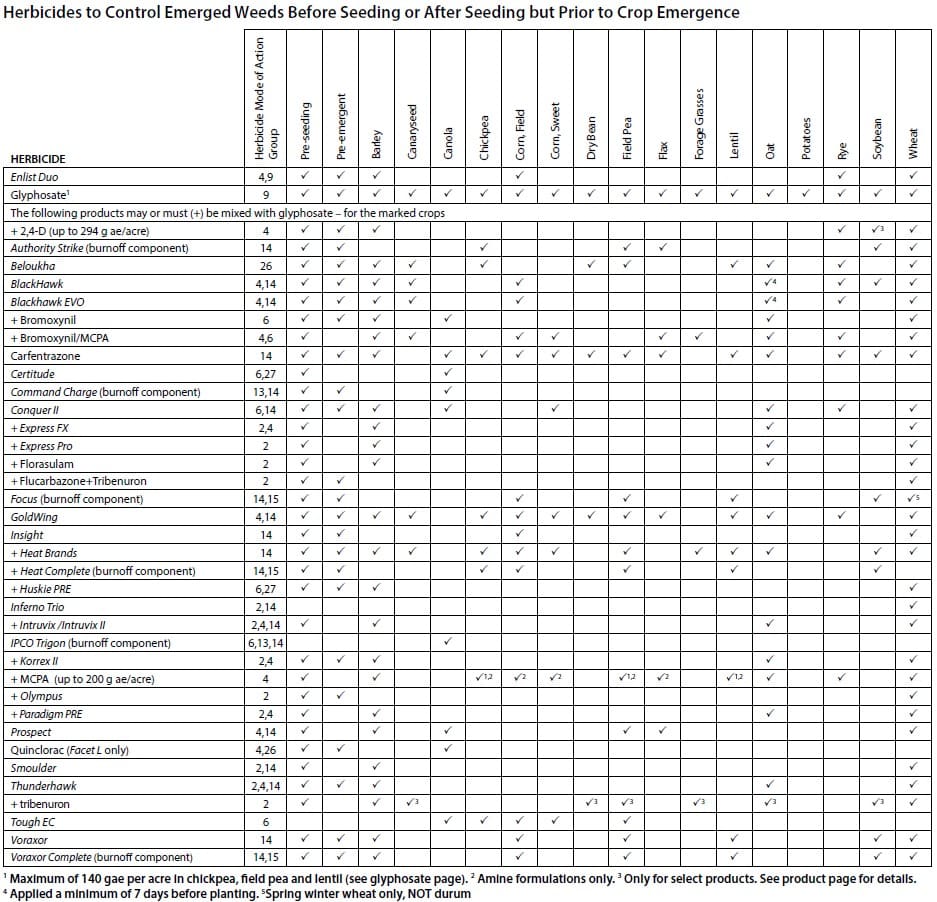
Major weeds of canola
The list of top weeds in canola/rapeseed, by relative abundance, has changed over time, based on the Prairie weed survey results from 1976 through 2017. However, green foxtail, wild oat, and wild buckwheat (with the exception of 1987) have remained among the top six 22.
Therefore, an important step in weed management is to identify the problem weeds present in each field. every year. Evaluate individual fields for weed types, populations and locations. Keep an up-to-date list of weeds found in each field. Local crop specialists can help identify the weeds and many good weed identification books are available.
Volunteer canola
Volunteer canola is a weed and competes with the crop for nutrients and water and sunlight. Volunteers in a canola crop do not make a positive contribution to yield. Volunteer canola left untreated can introduce seedling diseases and increase flea beetle pressure. In non-canola years, volunteer canola provides a host for blackleg and clubroot, reducing the effectiveness of crop rotation for managing these diseases.
Cleavers
Cleavers can be very competitive with canola because it clings to plants when growing toward the light and reduces crop development. The clinging bristles can result in swathing difficulties and bunching of the swath. More important, cleavers seeds are similar in size and shape to canola, making them a serious contaminant that will downgrade the crop. Canola that is graded No.1 Canada must have less than one per cent other seeds that are conspicuous and not readily separable from canola. This includes cleavers. The cut off is 1.5 per cent for No.2 and 2.0 per cent for No.3.
Preseed burnoffRefers to a pre-seed glyphosate (herbicide) application that stunts the growth of the perenial weeds in a field (since glyphosate only affects top growth and isn't taken up by the roots in the spring) in order to give the crop (to be seeding shortly after) a better chance at outcompeting the weeds for sunlight, water and nutrients. More is the most effective way to control cleavers. Fields with increasing populations of cleavers will need a higher rate of preseed burnoffRefers to a pre-seed glyphosate (herbicide) application that stunts the growth of the perenial weeds in a field (since glyphosate only affects top growth and isn't taken up by the roots in the spring) in order to give the crop (to be seeding shortly after) a better chance at outcompeting the weeds for sunlight, water and nutrients. More. The 180 grams (half-litre) rate of active per acre of glyphosate is not likely enough. A rate of 360 grams (one litre) per acre will control these weeds more effectively. If cleavers are larger, a 540 gram (1.5-litre) rate may be required. A selection of tank mixCombining two or more crop protection products (that are compatible) in one application. More partners can be added to pre-burn applications of glyphosate to improve cleavers control. If cleavers are a problem in a field, a fall application of glyphosate the season before following by a spring preseed burnoffRefers to a pre-seed glyphosate (herbicide) application that stunts the growth of the perenial weeds in a field (since glyphosate only affects top growth and isn't taken up by the roots in the spring) in order to give the crop (to be seeding shortly after) a better chance at outcompeting the weeds for sunlight, water and nutrients. More can go a long way to reduce populations. Overwintering cleavers are very hard to control and get big fast in the spring, so control them the fall before whenever possible.
Dig up a few cleaver plants to determine staging. Those with large established roots are probably winter annuals and will need a higher rate. Cleavers that emerge in the fall can survive a cold winter if they’re under a nice blanket of snow. Early spring control is essential; otherwise winter annuals will quickly grow to a size where herbicide control is much less effective. If cleavers are small and look like they germinated in the spring, a lower recommended rate may be enough. In-crop cleavers efficacy, regardless of herbicide system can be improved with the addition of quinclorac.
See the current research focused on understanding cleavers populations in western Canada on the Canola Research Hub.
Glyphosate-resistant kochia
Glyphosate-resistant kochia was first confirmed in Southern Alberta in 2011, making it the first glyphosate-resistant weed confirmed in Western Canada. Interestingly, a 2010 predictive model by Hugh Beckie, research scientist with AAFCAgriculture and Agri-Food Canada is a department of the Government of Canada. More in Saskatoon, ranked kochia first among weeds at risk of developing glyphosate resistance on the Prairies. The prediction was accurate.
Glyphosate-resistant kochia is now commonly found in all three Prairie Provinces 23. Kochia produces 15,000 to 25,000 seeds per plant, and mature weeds can spread these seeds over a fairly wide area, once they break off from their stems and start to tumble with the wind. Farmers will want to test “escapes” (kochia plants that aren’t killed by the herbicide applied to target them) for glyphosate resistance, so the weeds can be targeted for intense management before they start to shed their seeds. A few hours of hand rouging may be required, but this can be time well spent to stop a small patch from spreading.
The preseed window is a critical time to control kochia as 80 per cent of kochia seedlings emerge before the crop. It’s important to note that all kochia plants in Western Canada are considered Group 2 resistant. For good long-term management and prevention of glyphosate-tolerant kochia escapes, use a rotation of broadleaf control products with good activity on kochia and with mixes that include actives from Groups other than 2 and 9. Tank mixes and pre-packs that include bromoxynil, dicamba or Group 14 active ingredients are the choices available. Among those products, only CleanStart (with Group 14) is approved for use ahead of canola and must be applied at the high rate to control glyphosate-resistant kochia. Preseed kochia management ahead of cereals will allow more product choices. Taking measures to manage glyphosate-resistant kochia before it is visible in the field is critical to managing it successfully.
For more on this topic, please check out the following Canola Watch fundamentals articles: How to contain herbicide-resistant kochia.
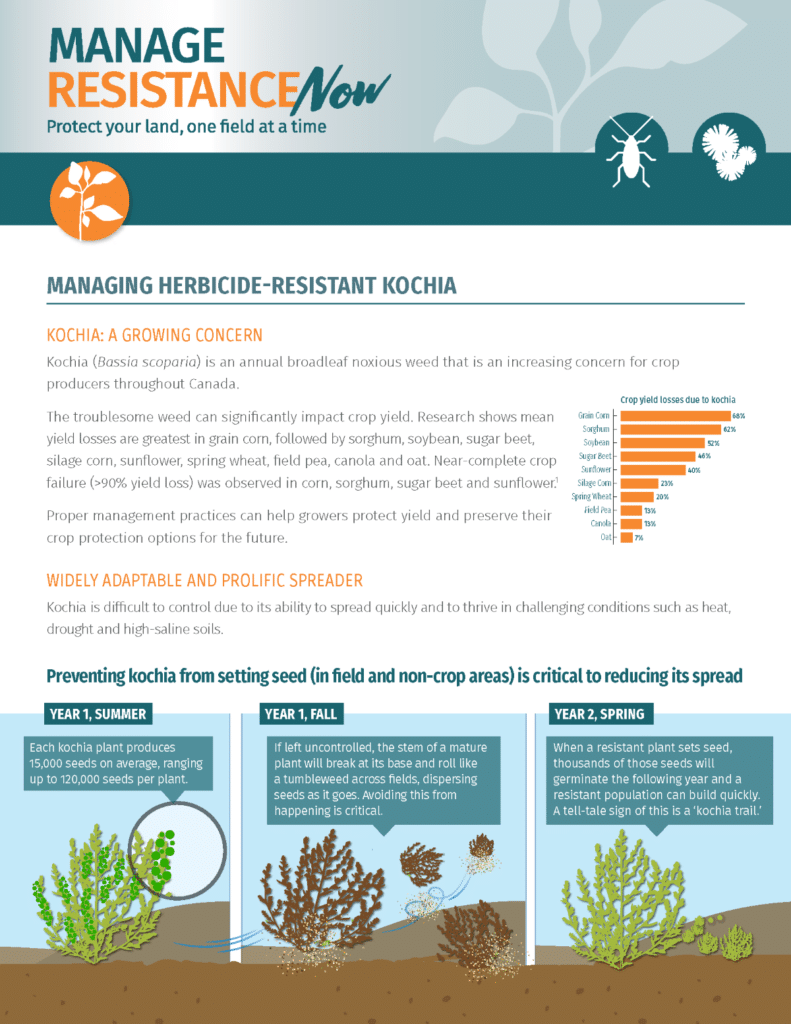
Canada thistle
Canada thistle is three to four times more competitive than wild oats. The graph below shows estimated yield losses of canola caused by Canada thistle, based on the number of thistle plants per square metre of canola crop.
Researchers at the AAFCAgriculture and Agri-Food Canada is a department of the Government of Canada. More in Lacombe, Alberta developed an equation to predict yield loss through competition from Canada thistle. The equation is:
Per cent yield loss = -3.83 + 1.4X (x is the number of Canada thistle shoots per square metre)
The more samples taken, the greater the accuracy in estimating yield loss. A minimum of 10 samples is recommended per quarter section. For example, if a canola field has an average of 15 Canada thistle shoots per square metre, the estimated yield loss would be:
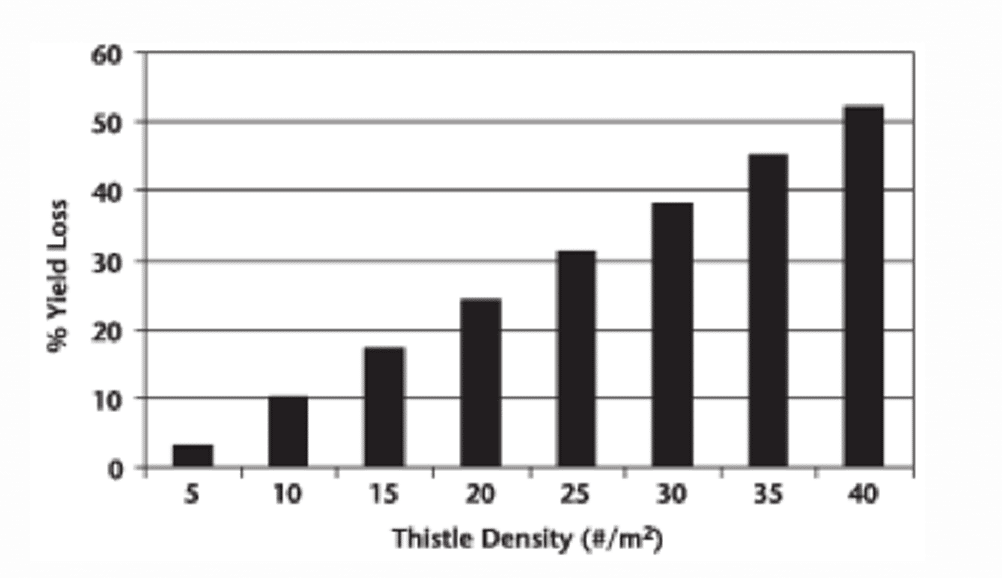
Per cent yield loss = -3.83 + 1.4 x 15 = 17
Since no control measure provides 100 per cent weed kill, and since weeds are not killed immediately on emergence, all of this loss can never be recovered. The recovery of at least 75 per cent of the yield loss by spraying with a herbicide would result in an increase of 213 kilograms per hectare (3.8 bushels per acre). Decisions must be made on whether the use of a herbicide is economical given current herbicide costs and canola prices.
Sow thistle
Sow thistle does not usually occur uniformly throughout fields, but where it does, the crop can suffer high yield loss. Soil, rainfall and farming practices influence the competition between canola and sow thistle.
Researchers at the AAFCAgriculture and Agri-Food Canada is a department of the Government of Canada. More in Regina, Saskatchewan developed an equation for determining yield loss in canola:
Per cent Yield Loss = -3.81 + 13.76 x (square root of X)
(Where X = the number of sow thistle rosettes and shoots per quarter of a square metre)
In a field with 20 sow thistle rosettes in a square metre (or five per quarter of a square metre) the yield loss would be:
Per cent yield loss = -3.81 + 13.76 x (square root of five)
= -3.81 + 13.76 x 2.24
= 27
In general, thistle populations increase in seasons of normal to above normal soil moisture. This can be important if the weeds are not controlled in the year before the canola crop.
Volunteer wheat and barley
Volunteer cereals are strong competitors at the early growth stages. Volunteer wheat and barley at seven to eight plants per square metre can reduce canola yield by 10-13 per cent, as shown in studies at the University of Manitoba.
Equal numbers of volunteer cereals were found to be 1.5 times as competitive as wild oats. At higher densities, barley was much more competitive than wheat.
Canola yield losses are more severe when volunteer wheat or barley emerges before the canola crop.
Wild oats can significantly reduce canola yields. Estimates of yield losses due to wild oat weed density have been developed for healthy, well-fertilized canola crops with good stand establishment.
Researchers at the AAFCAgriculture and Agri-Food Canada is a department of the Government of Canada. More in Lacombe, Alberta developed an equation to predict canola yield losses from wild oats:
Per cent yield loss = 3.22 x (square root of X), Where X = the number of wild oat plants per square metre
An average infestation of wild oats would range from 60 to 100 plants/m2. A heavy infestation would range from 300 to 500 plants per square metre. If a field had 100 wild oat shoots per square metre on average, the per cent yield loss would be: Per cent yield Loss = 3.22 x (square root of 100)
= 32.2 per cent
Green foxtail
Research by the Alberta Research Council (now Alberta Innovates) in Vegreville, Alberta has shown canola yield losses caused by green foxtail. The graph below summarizes this work.
Green foxtail can result in significant yield losses if it emerges ahead of or with the canola crop. If green foxtail density is less than 100 plants per square metre and the majority of the weeds have emerged more than one week after the crop, yield loss is expected to be insignificant. Green foxtail is a poor competitor in cooler regions unless in dense stands. Canola is an efficient competitor against green foxtail. Under low light intensity green foxtail plants grow very poorly and remain small.
Quackgrass
Research by the Alberta Research Centre (now Alberta Innovates) in Vegreville estimated yield losses in canola due to quackgrass density. The graph below summarizes this work.
The economic thresholdAn economic threshold is the level of infestation (ex. pest insect density) at which lost yield (ex. due to feeding/insect pest damage) exceeds the cost of the chemical and its application. More in canola is about 20 to 25 quackgrass shootspersquare metre, but varies with the price of canola. Quackgrass usually occurs at high densities in localized patches within a field, but can spread rapidly by its underground rhizomes. Pre harvest, post-harvest and preseed burnoffs are essential in the strategy to eliminate quackgrass populations in Western Canada.
Maximize herbicide application efficacy
Growers have two key considerations when it comes to spraying — good coverage and drift management. A fine mist spray may provide better coverage of the target area, but this mist is also more prone to drift. Drift means a loss of efficacy, a waste of product, and perhaps most worrisome, damage to non-target areas — including neighbor’s crops, shelterbelts and yard sites.
Tips to reduce spray drift
Choose a herbicide that can handle large droplets. With canola, growers often do not have much choice when it comes to herbicide. They use the product to match the herbicide tolerance system. Where possible, consider the following when making a herbicide choice:
- Glyphosate is suited to low drift (coarse droplet) sprays, but remember that at the low water volumes that favor glyphosate, coarse sprays may not provide enough droplets per square inch. A combination of coarse spray and low (but not ultra-low) water volume is best to make sure you get droplets on even the smallest weeds.
- Liberty can work with a coarse spray nozzle but it needs at least 10 gallons per acre to maintain efficacy.
- Group 2 products for the Clearfield system in general perform well with coarse sprays.
Use a low drift nozzle to produce a coarse to very coarse spray. Ideally, find a nozzle that can achieve a coarse spray at a broad range of pressures. But too coarse and coverage can be inadequate, especially at low water volumes. The image below uses water-sensitive paper to demonstrate coverage based on droplet size and water volume.
Keep the boom low. A boom at 50-60 centimetres (20-24 inches) above the target will have half the drift of a boom 90-100 centimetres (36-40 inches) above the target. Auto-boom height controllers make it possible to lower the boom and maintain the desired travel speed without having to worry about the boom tips hitting the ground.
One challenge with a lower boom is to achieve 100 per cent spray pattern overlap at the same time. Wolf prefers to see 100 per cent overlap, not the 30 per cent overlap in many recommendations, because that provides a uniform number of droplets across the whole field. Spray from one nozzle should reach to the middle of the spray pattern of the adjacent nozzle. Pick a fan angle and pressure that achieves this at a low boom height.
Aim for 100 per cent overlap nozzle to nozzle. This provides equal coverage across the whole boom width.
Know what’s down wind and what harms it. Canola is sensitive to drift. Consider your neighbor’s Roundup Ready canola when you’re spraying Liberty on InVigor canola, for example.
Let the weather help. Calm early mornings can actually increase spray drift damage. The spray can hang in the air, making it impossible to predict when and where it will settle. This dense cloud can do a lot of damage to a non-target field or yard site. Bright sunny days with some wind are ideal times to spray to minimize drift damage. In these conditions, thermal turbulence tends to move any spray that does hang in the air up and down instead of laterally along the ground. Anything that goes up is rapidly diluted in the atmosphere.
Do headlands and around yard sites first. Get these areas done first so that if the wind picks up you have a buffer area already created. When following unusual patterns, use GPS to track what areas have been sprayed.
Talk to people who might be affected. When spraying on days that are not ideal, talk to neighbors who might be affected by spray drift. Damaging a sensitive crop or a relationship is probably not worth the risk.
Better herbicide performance – tips
Here are ways to get the most from a herbicide:
Spray when weeds are actively growing. Herbicide activity is usually reduced when applied to weeds subjected to cold and/or moisture stress.
Follow label instructions. Specifically, apply the herbicide at the growth stage most susceptible to target weeds. Apply the recommended rate of herbicide. Use the water volume stated on the label. Use the wetting agent included or recommended. Do not add extra wetting agent unless indicated on the product label. Apply at weather conditions best suited to individual herbicides. (For more on this, read the section “Weather effect on herbicides performance”.)
Timing is more important than the method of application. AAFCAgriculture and Agri-Food Canada is a department of the Government of Canada. More research from Scott, Saskatchewan showed that spraying 7 days after crop emergence generated higher yields than spraying 17 days after emergence, no matter the droplet size. Finer spray may be more efficacious than coarse spray, but finding a suitable day to apply a fine spray without significant drift can be difficult. When it comes to crop yield, the research found that using a low drift nozzle early to get rid of weed competition is better than waiting longer for a relatively calm day to use a finer spray. Hire a plane if necessary to achieve the earlier spray timing.
If the coarse nozzle means you can spray sooner because the risk of drift is too high for a fine spray, then the coarse spray has a clear advantage.
Do not spray when wind velocity exceeds 15 kilometres per hour (nine miles per hour), or use a wind shroud on the sprayer.
Choose a nozzle that produces a coarse spray in the middle of its pressure range. A nozzle that produces a coarse spray through the middle of its pressure range provides the most flexibility to change spray pattern and droplet size in response to changing ground speed and pressures. For example, a nozzle that produces coarse spray at 40 to 80 psi offers more flexibility to slow down or speed up and still achieve a coarse spray. The charts shown below provide examples. The table below shows coverage based on nozzle spray type and pressure in gallons per acre (gpa).
Know the nozzle’s pressure range and choose the middle of it. This expands on the previous tip. When travel speed increases, spray pressure must increase considerably more to maintain the spray rate per acre. For example, to increase speed by 10 per cent, pressure may have to increase by 25 per cent. Droplet size shrinks and drift potential increases with higher pressure. Know what speed range a nozzle provides to achieve coarse sprays. This range may be fairly narrow for high pressure nozzles. For low pressure nozzles, the speed range tends to be a lot wider.
Higher ground speed is not the only way to increase productivity. Speeding up increases the amount of acres covered in a day, but it also causes greater pressure fluctuations to maintain spray rates over a range of speeds. Travel slower to reduce the amount of fine droplets, and make it safer to drive with the boom lower. The pressure gauge can be used as a speedometer.
Consider other methods besides higher speeds to increase productivity.
- Larger tanks to cover more acres between fills. Keep in mind that larger tanks add weight. Heavier units cannot always get through a field in soft conditions where a lighter more nimble unit can. If a heavier higher horsepower unit can get through a soft field, it often leaves ruts.
- Use a wider boom. With automatic boom height control, wider booms are easier to handle. Going from a 90 to 120 foot boom increases productivity significantly. Make sure the pump can achieve consistent pressure across the whole width.
- Choose a sprayer with a more convenient loading area and with a high speed pump. This will reduce fill time.
Select water volume and spray quality based on target weeds and herbicide characteristics.
- Grassy weeds are the most challenging target because they have small and vertical leaves that are difficult to wet. Avoid very coarse sprays on grassy weeds. Grassy weeds also tend to require higher water volumes.
- Broadleaf weeds will tolerate larger droplets.
- Contact products need better leaf coverage than systemic products.
- Test the wettability of weeds. Pour some water on the weed. A weed that gets wet and stays wet is unlikely to present a droplet size issue. Coarse sprays will usually provide good efficacy. But if the water beads and runs off, use higher water volume and do not use a very coarse spray. Cleavers, lamb’s-quarters and kochia are weeds that are hard to wet.
- Canopy density affects performance. If a spray needs to get through a dense canopy to hit low targets, use a higher water volume and slower travel speed.
- Avoid the combination of extra coarse droplet size and low water volumes. This will not provide the droplets per square inch required to hit every weed.
Use high quality water. Water containing large amounts of organic matter, clay, and other particles will result in nozzle plugging and reduced weed control.
Double nozzles (with forward and backward facing jets) may be slightly oversold for weed control. Double nozzles are more suited to fungicide application on a vertical target, such as a wheat head.
But in studying double nozzles, AAFCAgriculture and Agri-Food Canada is a department of the Government of Canada. More researchers found that angled tips tend to provide better coverage, especially for low drift nozzles at low boom heights. In that case, a tip that angles spray forward can improve spray efficacy. With a high boom, angling does not provide the same benefit.
Not all weeds can be controlled with large droplets. A good test to see how well weeds will retain a herbicide spray is to shower them with water and see how wet they get. If the water sticks, they should retain a coarse spray fairly easily. If the water rolls off and the plant stays dry, these weeds may be harder to control with larger droplets. Cleavers, kochia, lamb’s-quarters, and volunteer canola are examples of hard-to-wet weeds. As they get larger and their waxy cuticle prevents herbicide uptake.
For these weeds:
- Do not use very coarse droplets. Dial down to coarse or even medium droplets if it’s warm, sunny and not too windy.
- Use higher water volumes. With Liberty, use at least 10 gallons per acre. Glyphosate tends to work better with lower volumes, but don’t have the volume so low that there aren’t enough droplets to hit all small weeds.
- Contact products need better leaf coverage than systemic products. Higher water volume and smaller droplets are important for contact products.
However, while the Characterizing turbulent spray deposition from self-propelled sprayers project concluded that the “best” configuration of low boom height, slow travel speed and coarser spray, it was only somewhat more uniform compared to the alternative of higher boom height, faster travel speed and finer spray.
Weather effects on herbicide performance
Herbicides in general tend to work best in warm sunny conditions when weeds are actively growing and cycling nutrients into their growing points. In these conditions, weeds will take in herbicides most efficiently.
However, ideal conditions can vary by product. For example, cloudy days don’t provide the photosynthetic activity required for many herbicides, including Group 10 glufosinate. And nights near freezing followed by days with highs that barely reach 10 C will not provide high metabolic activity required for best results from Group 9 glyphosate.
Performance is on a sliding scale. Cloudy days with highs of 10 degrees Celsius, after a night near zero degrees Celsius will tend to result in herbicide performance at the low end. Sunny days with highs of 15 degrees Celsius after a night of three degrees Celsius will provide improved control. Sunny days with highs of 20 to 25 degrees Celsius after a night of 10 degrees Celsius will provide optimum control.
Cool humid conditions are also prime conditions for herbicide injury to the crop. The leaf cuticle (waxy layer) is thinner allowing more rapid uptake of herbicide into the plant and cool conditions reduce the speed at which the herbicide is inactivated in the crop. This can lead to a flash of injury in the crop. This injury is temporary in most cases and once good growing conditions return, the crop recovers and yield loss is rare.
Talk to your local product rep to see how they will support the use of their product when applied in cool temperatures. Set expectations according to weather conditions.
This Canola Watch article has suggestions on how to manage herbicide applications in different weather conditions.
Incorporation of soil-applied herbicides
The recommended procedures for mixing or incorporating pre-emergent herbicides into the soil are found on the herbicide label. Such procedures will usually give the desired results. Exceptions occur due to the wide range of soil and climatic conditions. Tillage and incorporation procedures that are necessary for these herbicide applications are not favourable to soil moisture conservation and soil erosion prevention.
Factors to consider when incorporating herbicides
Herbicide
The depth of incorporation for maximum effectiveness varies with the herbicide and the weed to be controlled. Course texture soils and soils with low organic matter may require different herbicide rates than other soils.
Soil Conditions
Uniform application and proper incorporation is essential to receive full benefit from a soil-incorporated herbicide. Loose, mellow soils are ideal for mixing the herbicide uniformly to the desired depth. Hard and lumpy soils, and those that are wet and sticky make it difficult to get uniform and proper mixing.
Dry soils will, in some cases, limit herbicide activity. An incorporation procedure that dries out the soil just before or even after seeding can result in poor emergence of the crop. Timing and method of incorporation are important where weather conditions will dry out the soil. A loose or lumpy soil surface will lose moisture in fall and spring. Harrow and pack cultivated soils that are likely to dry out after every tillage operation. Granules placed on hard, lumpy soil before incorporation can fall between the lumps and go too deep, whereas liquid attaches to the soil. Therefore, if granules are to be used, it may be necessary to pre-work the soil to get it into a condition where the granules may be mixed within the desired soil layer. Lumpy or sticky soils may require several tillage operations to get them into a good condition for proper incorporation.
Where soil erosion is not a problem, fall application is usually preferable to conserve spring seedbed moisture. On some soils, the recommended incorporation procedure for either fall or spring may leave the soil so loose, soft and fine that it will be subject to both wind and water erosion. On these soils, consider a minimum incorporation if alternate methods of weed control are available.
Incorporation Equipment
Harrows are very useful for shallow incorporation. Tine harrows behind cultivators contribute to better mixing, due to the lively action of the tines. Drag harrows on stubble fields may not work well for incorporation if they are constantly loaded with a lot of trash.
Tandem disc harrows, discers and any disc-type implement will provide deeper incorporation, more soil breakdown and faster and more uniform mixing to the depth of tillage than most other implements. Use these where deep incorporation is needed, where the soil is lumpy or sticky and where soil erosion is not a problem.
Tilling before applying a herbicide will produce a loose but smooth soil surface. This increases the depth and uniformity of herbicide incorporation.
Cultivators tend to give shallow incorporation and uneven mixing. Deep tillage of 10 centimetres (four inches) or more will give less soil disturbance. For good mixing, a higher travel speed of 10 to 13 kilometres per hour (eight miles per hour) is necessary. This higher speed throws soil upward and sideways to give more even incorporation. Higher speeds also help to break up lumps. Any brand of cultivator can be used, but shank spacing, speed, depth and kind of sweeps must be adjusted.
In stubble, the most effective incorporation of liquid herbicide is obtained if the field is first worked until about two-thirds of the surface is black. Granules can be applied directly to stubble before tillage, but spread the straw bunches. Weed or volunteer crop growth on fields will also absorb liquid herbicide.
Choose the incorporation procedure after a careful assessment of the field, climatic conditions and herbicide requirements.
Cleaning the sprayer tank
Properly cleaning a sprayer tank and boom protects a sensitive crop. It protects people working with the sprayer. It protects the sprayer and its components.
Practical tips to clean a sprayer tank and boom
Be prompt and thorough. Remove pesticide from mixing and spray equipment immediately after spraying – it makes the job easier. The main areas of concern are the tank wall, sump, plumbing, and filters. First, spray the tank completely empty while still in the field. It’s okay to cover previously sprayed areas – all herbicides must be crop-safe at twice the label rate to be registered by the PMRA. Reduce the rate to be certain. Second, add 10x the sump’s remnant of clean water, circulate, and spray it out in the field as well. Repeat. These two rinsing steps will take care of the majority of the cleaning and won’t take very long. Having a clean water tank on the sprayer and a wash-down nozzle makes this job easier.
Do a visual inspection. Herbicide residue may precipitate out of solution in some parts of the sprayer or plumbing. A thorough visual inspection can identify these problem areas and ensure that they are cleaned properly.
Clean the tank wall. Removal of residues from tank walls is best accomplished with a direct, pressurized spray. Make sure all parts of the wall have been in contact with clean water. Use a wash-down nozzle if it provides complete and vigorous coverage of the interior tank surface.
Empty the sump as completely as possible by spraying it out. Any spray liquid or herbicide concentrate remaining in the sump area will be re-circulated in the sprayer. In this case, the only way to remove the remaining herbicide is through dilution by repeatedly adding water and each time draining the sump as much as possible.
Plumbing can be a significant reservoir of herbicide residue. To remove residue from plumbing, pump clean water through the boom while ensuring that all return and agitation lines also receive clean water and all residue is flushed out. This may require opening and closing various valves several times, and repeating the process with new batches of clean water.
Use several small washes. The most effective use of a volume of rinse water is to divide it equally across several repeat washes. For example, a single 600 gal wash is as effective as two washes with 70 gallons each, and three with 30 gal each, assuming a 10 gallon sump remainder. More wash cycles allow for less water in total.
Clean filters. Nozzle screens and in-line filters can be a significant reservoir for undiluted or undissolved herbicide and are one of the most overlooked parts of sprayer decontamination. Remove all filters and nozzle screens and thoroughly clean these with fresh water. Run clean water through plumbing leading to the screens.
Clean all nozzles in a nozzle body. When cleaning a spray boom, rotate through all nozzles in a multiple-nozzle body to ensure clean water reaches all parts of these assemblies. Remove screens that may have been used with herbicide, even if just for a short while.
Use tank cleaning adjuvants. Adjuvants such as ammonia can assist the tank decontamination process. Ammonia does not neutralize herbicides, but it does raise the pH of the cleaning solution which helps sulfonylurea herbicides dissolve. When decontaminating after use of an oily (EC) formulation, the use of a wetting agent such as AgSurf will assist in removing oily residue that may trap SU herbicide on tank and hose material. Commercial cleaners are available.
Dispose rinsateA liquid mixture of pesticides diluted by water and cleaning agents produced from cleaning pesticides application equipment or pesticides containers after use. More carefully. Ideally, finish with an empty tank, having sprayed it all on the field. Do not drain the tank while stationary unless you are certain it is free of pesticide and that you are away from sensitive areas and waterways.
A new area of research that addresses the issue of rinsateA liquid mixture of pesticides diluted by water and cleaning agents produced from cleaning pesticides application equipment or pesticides containers after use. More disposal is biobeds. Biobeds contain a mixture of soil, compost, and straw to host the microbes that degrade pesticidesPesticides (herbicides, insecticides or fungicides) used to protect against or reduce the amount of damage caused by weeds, pest insects or plant diseases. More. Initial results show that placing dilute pesticide waste into biobeds breaks them down more quickly and prevents them from reaching ground waters more effectively than placing them onto soil.
For more on sprayer tank clean out, check out the Sprayer tank clean out tips Canola Watch article and see the Introduction section of the Guide to crop protection or Guide to field crop protection.
Footnotes
- Smith, E. 2013. Economic profitability and sustainability of canola production systems in Western Canada[↩]
- Blackshaw, R. E., Brandt, S., Johnson, E. N., Harker, K. N., O’Donovan, J. T., Turkington, K., & Kutcher, R. 2011. Which crop inputs have the greatest impact on canola yield? Proceedings from 13th International Rapeseed Congress, Prague, Czech Republic. 389-392.[↩]
- Geddes, C.M., Tidemann, B.D., Ikley, J.T., Dille, J.A., Soltani, N., & Sikkema, P.H. 2022. Potential spring canola yield losses due to weeds in Canada and the United States. Weed Technology. 36(6):884-890. doi:10.1017/wet.2022.88[↩]
- O’Donovan, J.T., Harker, K.N., Clayton G.W., & Blackshaw, R.E. 2006. Comparison of a Glyphosate-Resistant Canola (Brassica napusAlso referred to as Argentine canola, it is the species of canola currently commonly grown in Canada. More L.) System with Traditional Herbicide Regimes. Weed Technology, 20, 494–501.[↩]
- Sapsford, K.L., Holm, F.A., Johnson, E.N., & Cleazy G. 2012. Timing of Spring Application for Winter Annual Weed Control. Poster.[↩]
- Harker, N.K., O’Donovan, J.T., Clayton, G.W., & Mayko, J. 2008. Field-Scale Time of Weed Removal in Canola. Weed Technology. 22(4), 747-749. https://doi.org/10.1614/WT-08-107.1[↩]
- Canola Council of Canada. 1998. Canola Production Centre 1998 report (‘Time of weed removal trial’ section. Available on the Canola Research Hub.[↩]
- Canola Council of Canada. 1999. Canola Production Centre 1999 report (‘Weed removal timing trial’ section. Available on the Canola Research Hub.[↩]
- Canola Council of Canada. 2000. Canola Production Centre 2000 report (‘Weed removal timing trial’ section. Available on the Canola Research Hub.[↩]
- Martin, S.G., Van Acker, R.C., & Friesen, L.F. 2001. Critical period of weed control in spring canola. Weed Science. 49(3):326-333. doi:10.1614/0043-1745(2001)049[0326:CPOWCI]2.0.CO;2[↩]
- Harker, K. N., Clayton, G. W., Blackshaw, R. E., O’Donovan, J. T., & Stevenson, F. C. 2003. Seeding rate, herbicide timing and competitive hybrids contribute to integrated weed management in canola (Brassica napusAlso referred to as Argentine canola, it is the species of canola currently commonly grown in Canada. More). Canadian Journal of Plant Science. 83(2): 433-440. https://doi.org/10.4141/P02-073[↩]
- Smith, E. 2013. Canola growers survey. Available on the Canola Research Hub.[↩]
- Wheatland Conservation Area. 2013. Timing of Weed Control in Herbicide Tolerant Canola. Available online (June 2024[↩]
- Willenborg, C. Blackshaw, R. O’Donovan, J. Harker, N, Strelkov, S. & Tozzi, E. 2014. Quantifying the risks associated with late and sequential herbicide applications in herbicide-resistant canola systems. Available on the Canola Research Hub (June 2024).[↩]
- Tidemann, B., & Harker, N. 2021.Mitigating herbicide resistance – investigating novel integrated weed management systems. Available on the Canola Research Hub[↩]
- Canola Council of Canada. 2024 Canola grower survey. Summary featured in this March 2025 Canola Digest article.[↩]
- Canola Council of Canada. 2024 Canola agronomy provider survey. Summary featured in this January 2025 Canola Digest article.[↩]
- Geddes, C., Beckie, H., Sharpe, S., Leeson, J., Tidemann, B., Neeser, C., & Jones, T. 2019. The next generation of Prairie herbicide-resistant weed surveys and surveillance. Available on the Canola Research Hub.[↩]
- 2025 Guide to Crop Protection (from the Saskatchewan Ministry of Agriculture[↩]
- Ken Kirkland, AAFCAgriculture and Agri-Food Canada is a department of the Government of Canada. More in Scott, Saskatchewan. unpublished[↩]
- Harker, K. N., Clayton, G. W., Blackshaw, R. E., O’Donovan, J. T. & Stevenson, F. C. 2003. Seeding rate, herbicide timing and competitive hybrids contribute to integrated weed management in canola (Brassica napusAlso referred to as Argentine canola, it is the species of canola currently commonly grown in Canada. More). Can. J. Plant Sci., 83, 433–440.[↩]
- McCallum, B.D., Geddes, C.M., Chatterton, S., Peng, G., Carisse, O., Turkington, T.K., Olfert, O., Leeson, J., Sharpe, S., Stephens, E., Hervet, V., Aboukhaddour, R., & Vankosky, M. 2021. We stand on guard for thee: A brief history of pest surveillance on the Canadian Prairies. Crop Protection, 149, article 105748. https://doi.org/10.1016/j.cropro.2021.105748[↩]
- Leeson, J. & Sharpe, A. 2023. Glyphosate-or auxinic-resistant kochia and Russian thistle Prairie survey. Available on the Canola Research Hub.[↩]
